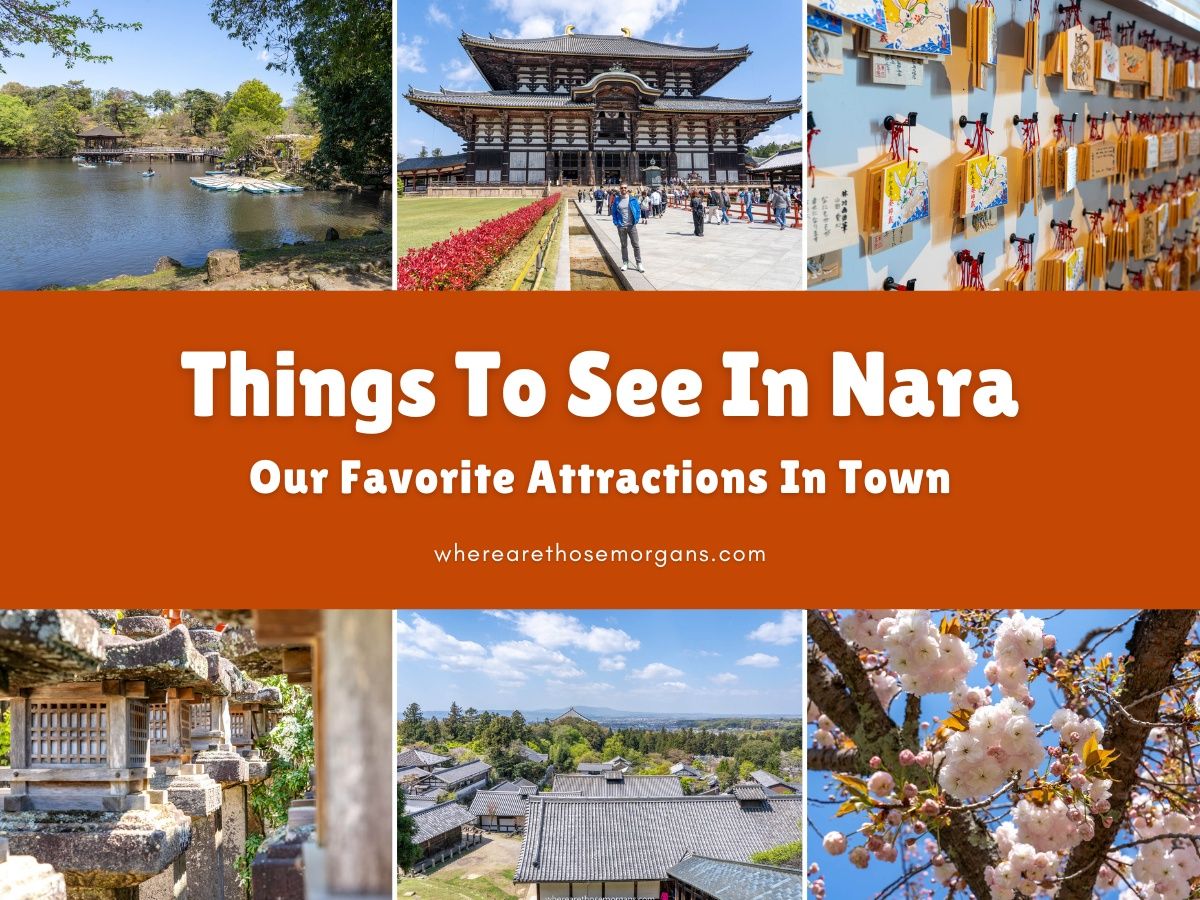
We’ve spent 5 weeks traveling around Japan in the spring and fall seasons, and during both trips we made sure to visit Nara because it’s such a beautiful and unique destination. Nara was the first permanent capital of Japan so it’s got tons of history, and it’s located less than one hour from Kyoto or Osaka by train so it’s a popular day trip.
We took a train from Osaka to Nara when we first visited back in 2019, arriving late in the afternoon and spending a night in a fantastic traditional onsen ryokan (read our Japanese onsen guide to learn more) before exploring for half a day in the rain and eventually taking a train to Kyoto. It was a bit too rushed, so when we visited Nara again in 2023, we made sure to arrive early in the morning and leave later that evening so we had a full day to check off everything on our bucket list. Read more about us.
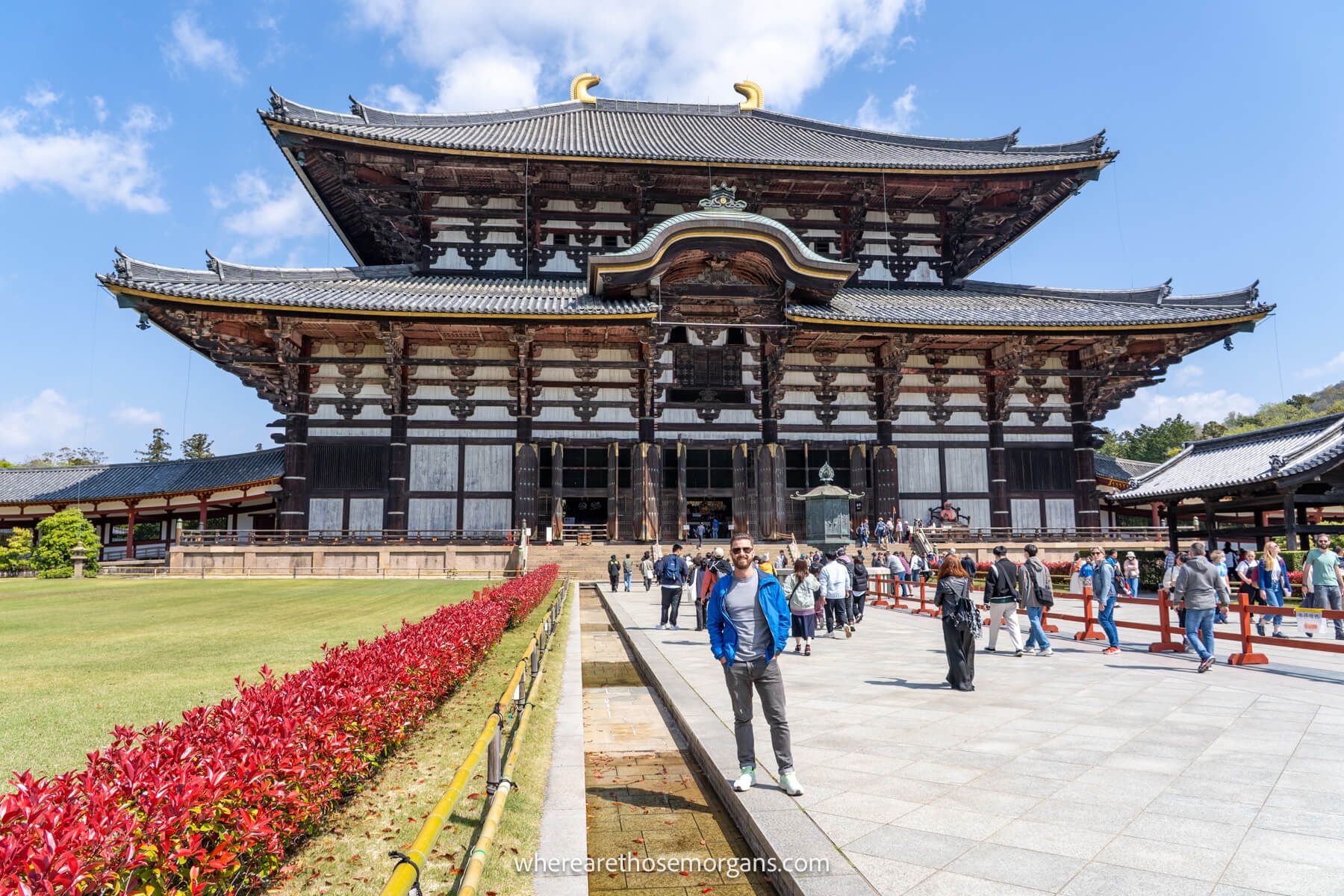 Mark standing in front of the entrance to Todai-ji Temple
Mark standing in front of the entrance to Todai-ji Temple
Overall we think Nara is a fantastic place to visit, and it’s just not about those famous deer you might have heard about. In this guide we show you the experiences we think are unmissable on a first trip to Nara, based on our two trips. Okay, let’s begin!
Note: Our content is reader supported and contains affiliate links. If you make a purchase through one of these links, we may earn a small commission at no extra cost to you and it helps us keep this site running.
Explore Todai-ji Temple
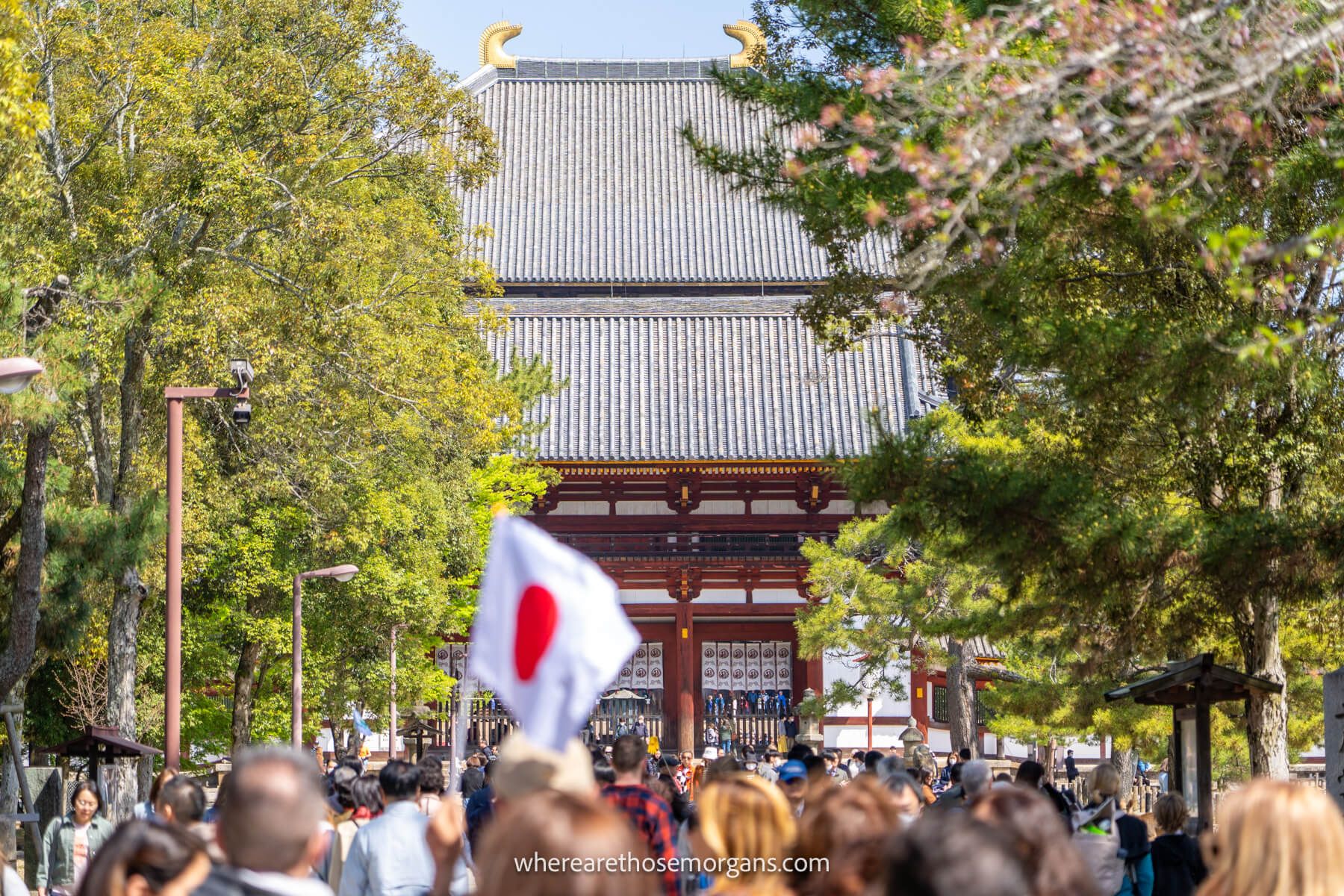 Tour groups heading to the Chumon-Gate
Tour groups heading to the Chumon-Gate 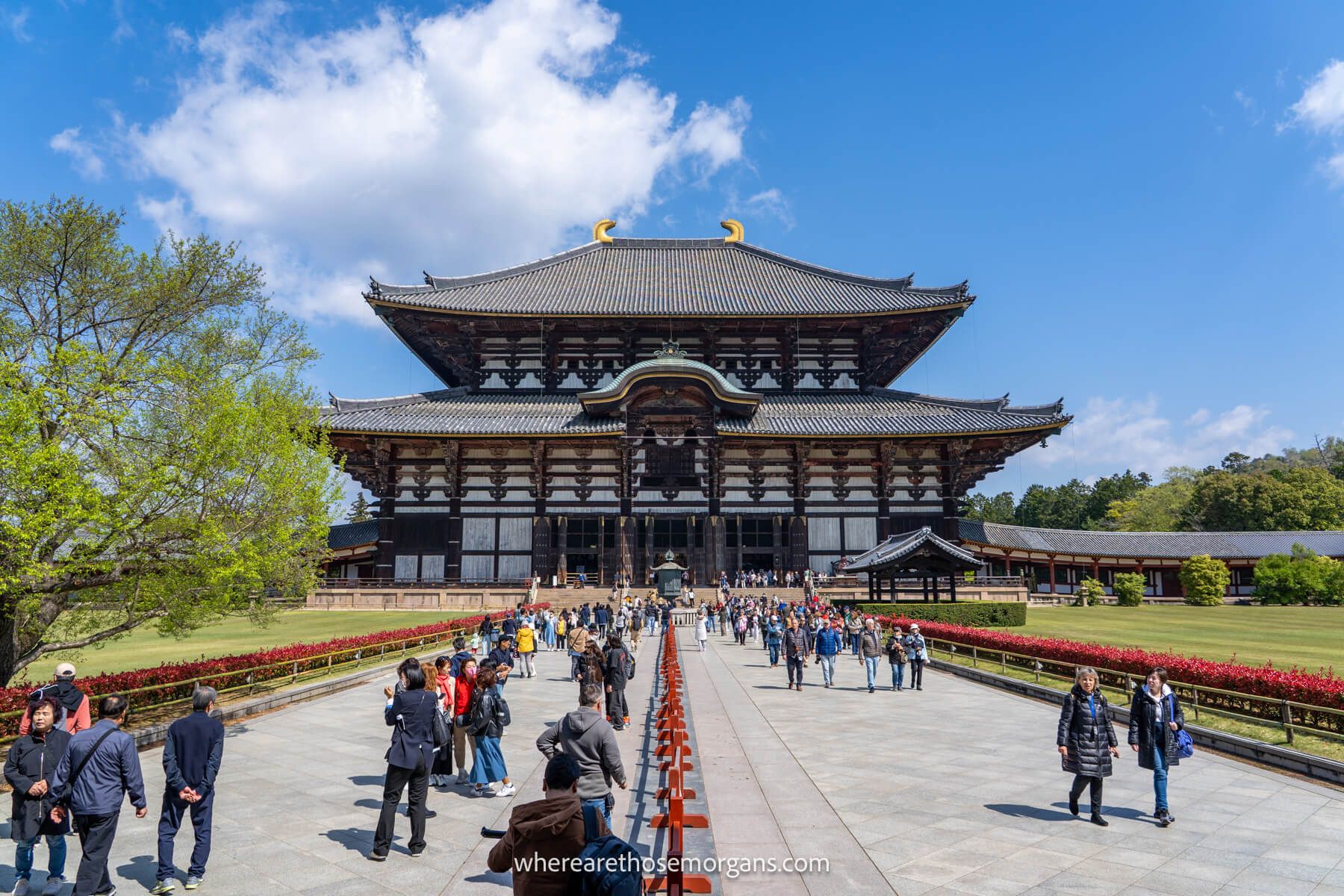 Visitors entering and exiting Todai-ji Temple on a beautiful spring morning
Visitors entering and exiting Todai-ji Temple on a beautiful spring morning
Let’s kick things off with one the most popular attraction in town – Todai-ji Temple. This is Nara’s centerpiece and one of Japan’s largest wooden buildings. And if the gigantic and impressively detailed exterior isn’t enough to wow you, the views only get better inside.
The statue of Vairocana Buddha (the Buddha of Light) standing at 14.98 meters high was far more striking than we expected. We knew it was one of the world’s largest bronze statues, but it still felt really imposing when we saw it.
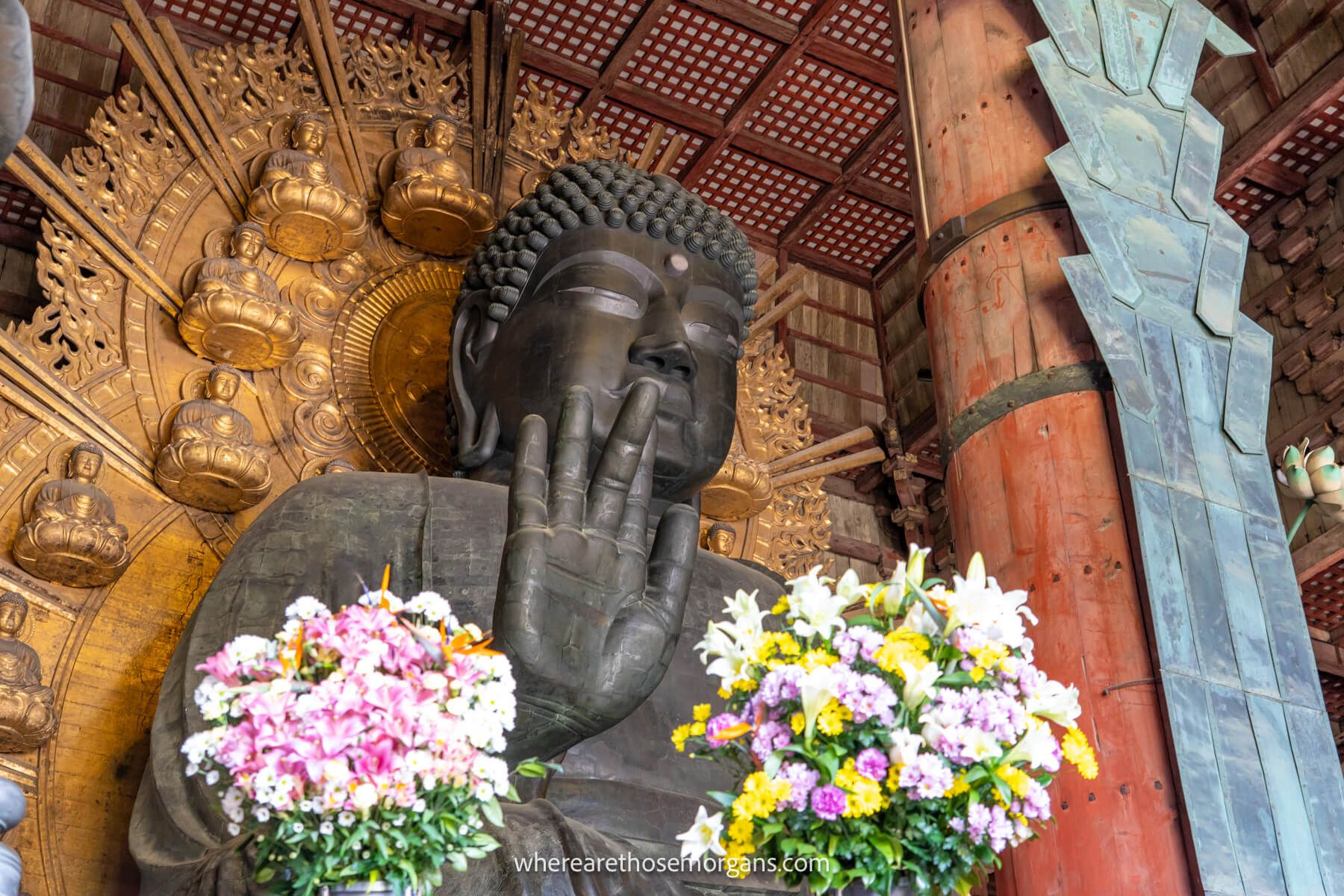 Vairocana Buddha inside the temple
Vairocana Buddha inside the temple
Todai-ji is a very important landmark and it’s always busy. We learned this the hard way when we visited during a typhoon and torrential downpour expecting to be the only people there, but the crowds were still enormous. It has a fantastic location nestled within Nara’s popular deer park, and you can feed the sika deer on your way to the temple.
One of our favorite things to do inside is crawl through Buddha’s Nostril, which we found in a small hole near the base of one of the large wooden pillars. It’s said this hole is the same size as Buddha’s Nostril on the large bronze statue and crawling through will help you achieve enlightenment. The hole was closed during our second visit in early 2023 due to the pandemic, but it has since reopened.
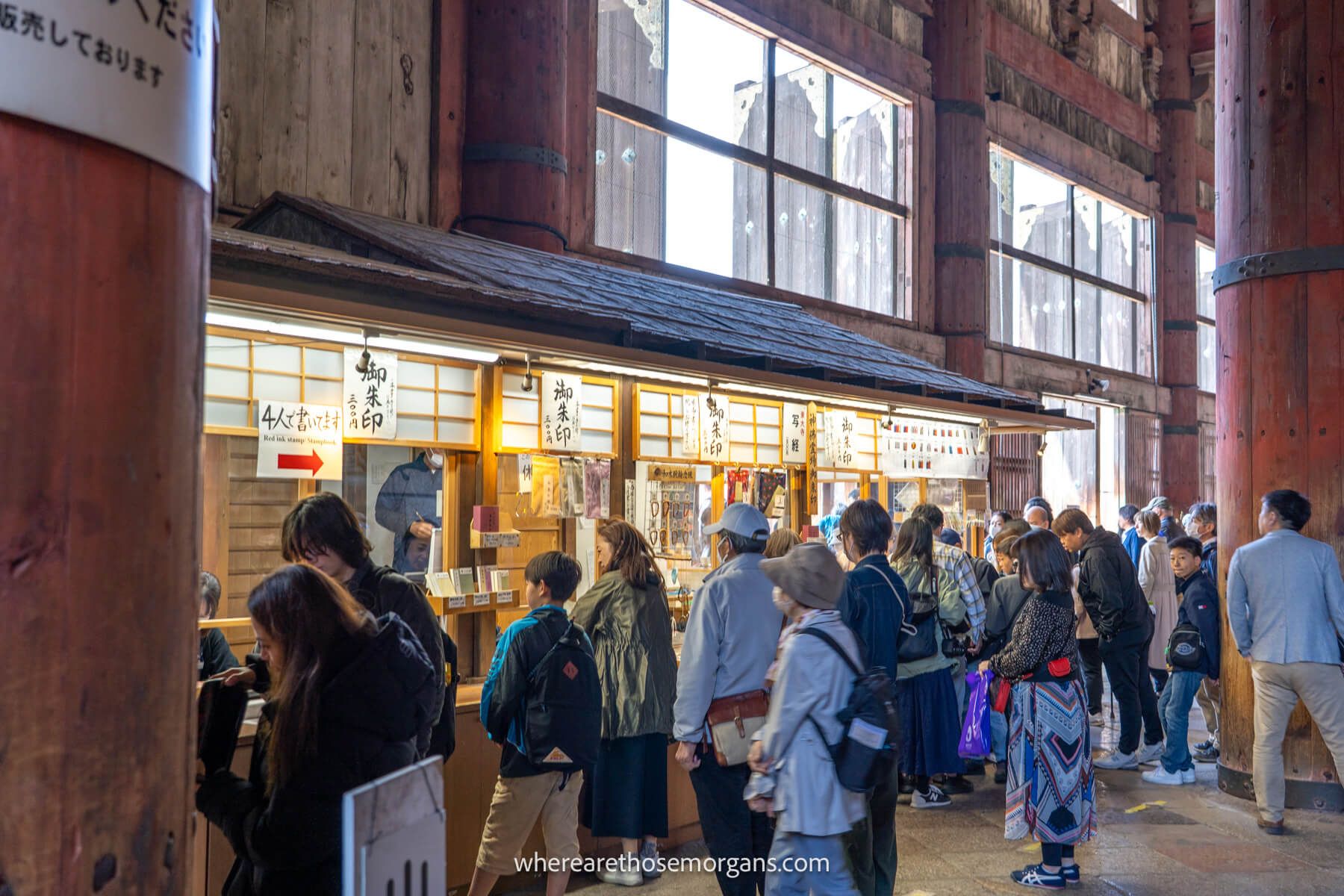 Long lines of people waiting for entry
Long lines of people waiting for entry
Admission for Todai-ji Temple is 800¥ for adults and 400¥ for children (6-12 years old). We paid before entering the Great Buddha Hall near the Chumon-Gate and had to wait in a small line. You can buy a Great Buddha Hall and Todai-ji Museum joint pass for ¥1,200 (¥600 for children), if you want to visit the museum too.
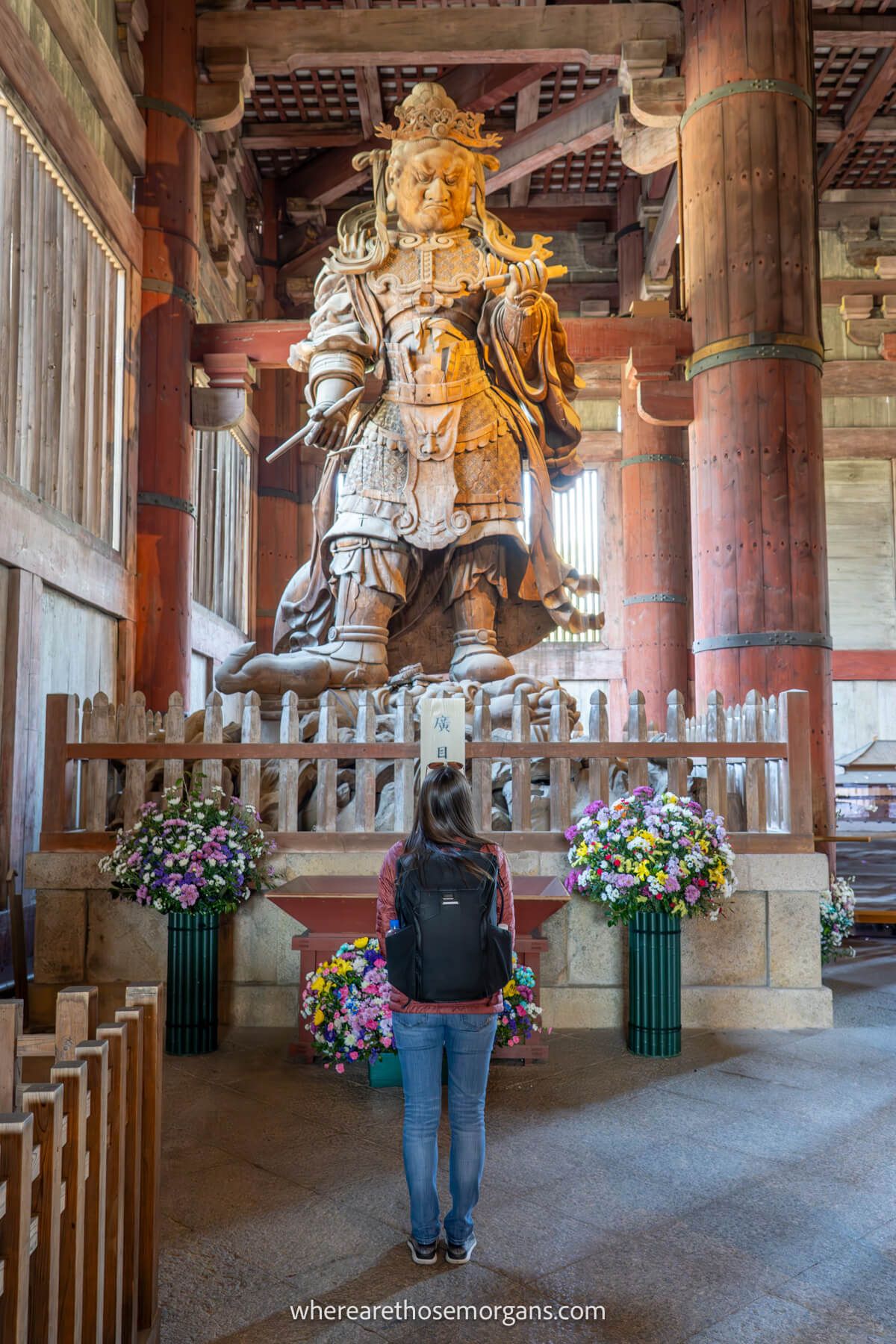 Make sure you visit the other sections of the Great Hall
Make sure you visit the other sections of the Great Hall
The main hall is open from 07:30-17:30 April to October and 08:00-17:00 from November to March. Visit the official website for more information.
Don’t Miss Nigatsu-do Temple
As you head east in the Todai-ji complex, you’ll come across Nigatsu-do. It’s a sub-temple of Todai-ji, but we think it deserves its own mention. We missed this temple on our first visit so we made sure to see it the second time around.
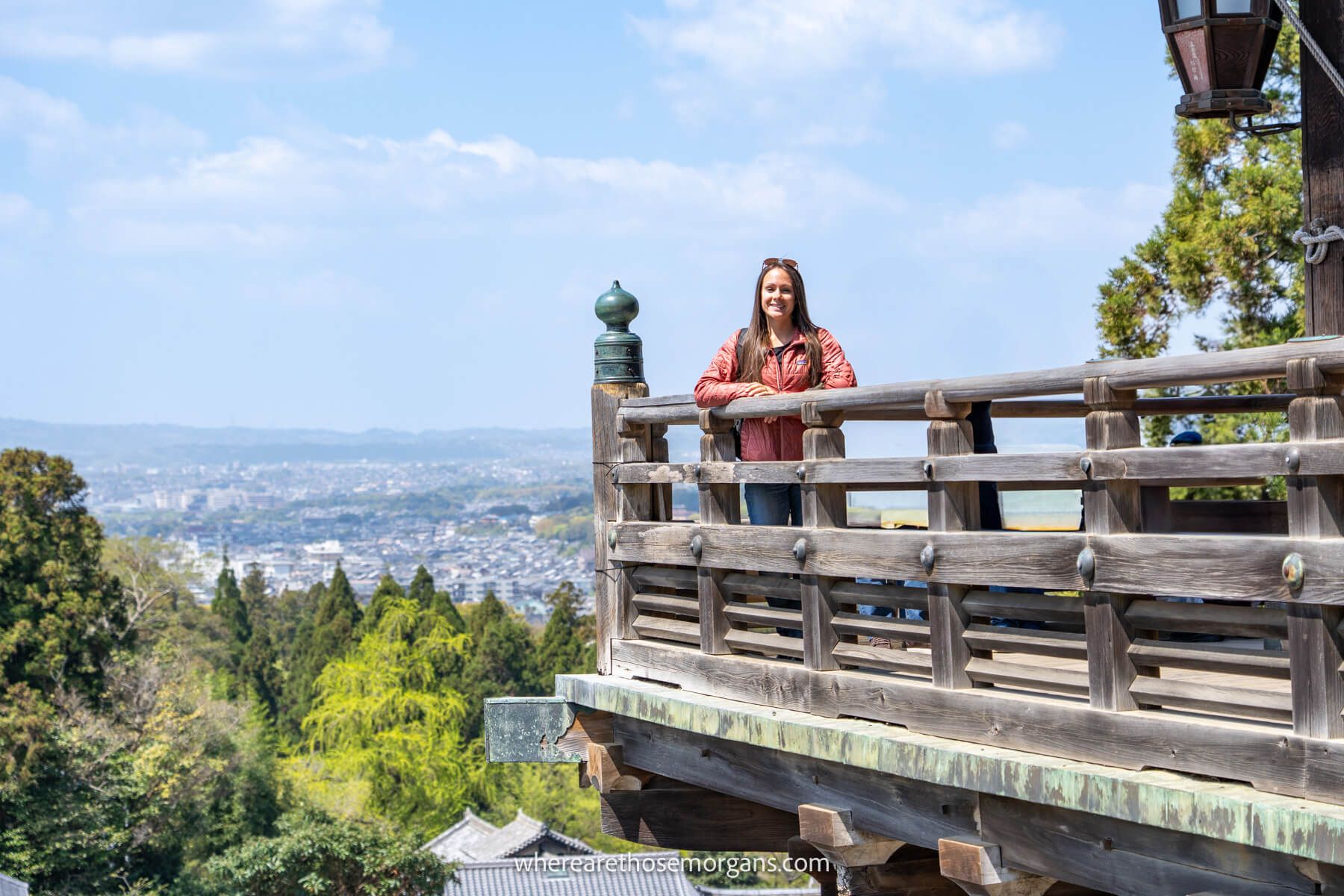 Kristen on the balcony of Nigatsu-do
Kristen on the balcony of Nigatsu-do
Nigatsu-do is famous for the Omizutori ceremony that takes place from March 1st to March 14th with the main fire event happening on March 12th. During the ceremony, monks carry large flaming torches and set the temple’s balcony on fire.
Why? Because it’s believed the embers from the fire will be good fortune for the upcoming year. If you’re in town for the ceremony, make sure you add it to your Nara itinerary.
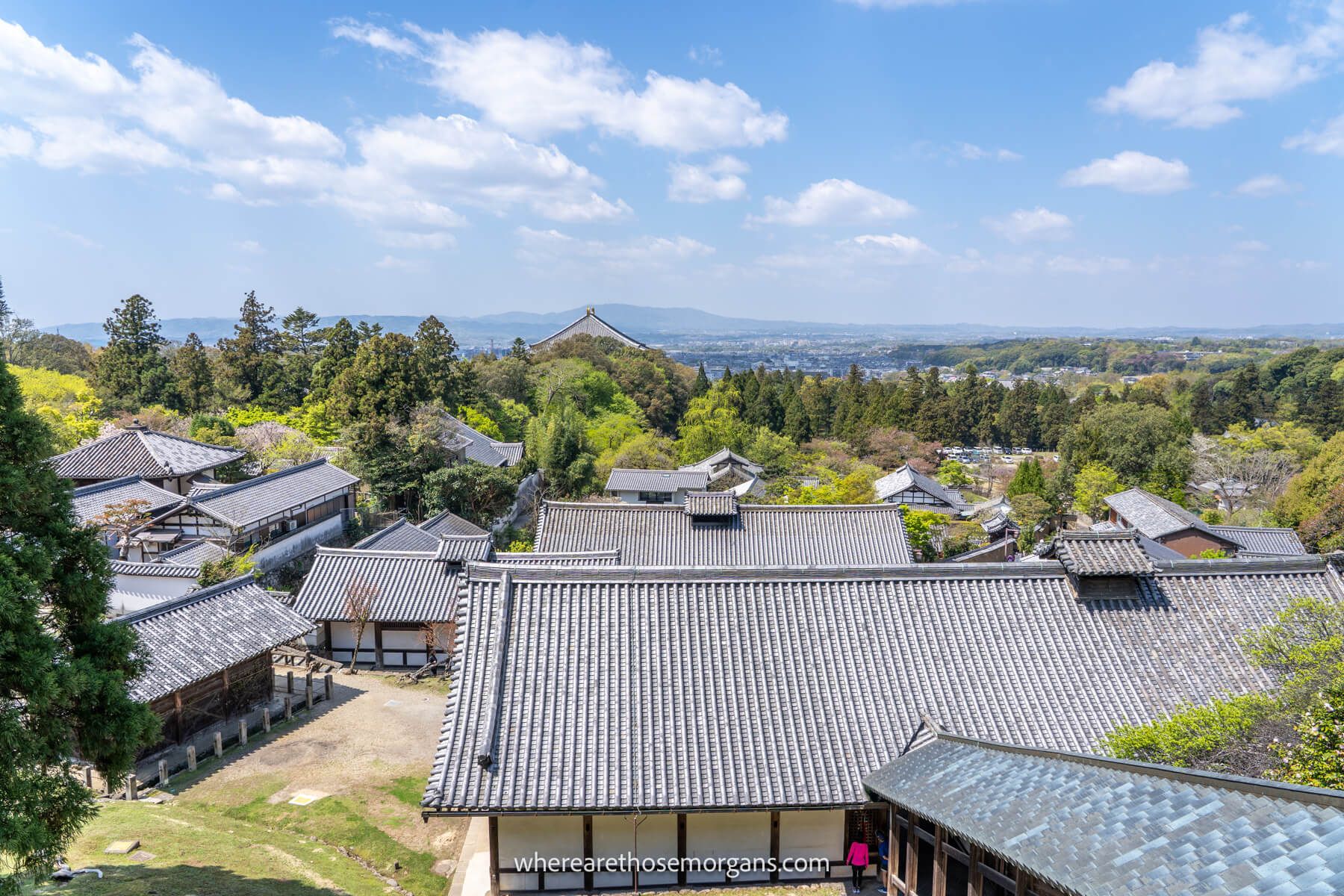 The sprawling view over Nara from Nigatsu-do
The sprawling view over Nara from Nigatsu-do
Without a doubt, we think the best part about visiting Nigatsu-do is the panoramic terrace. On a clear day, you’ll see sweeping views of the city’s main attractions including Todai-Ji’s Great Buddha Hall, Kofukuji’s five-story pagoda and the border of the Nara prefectures.
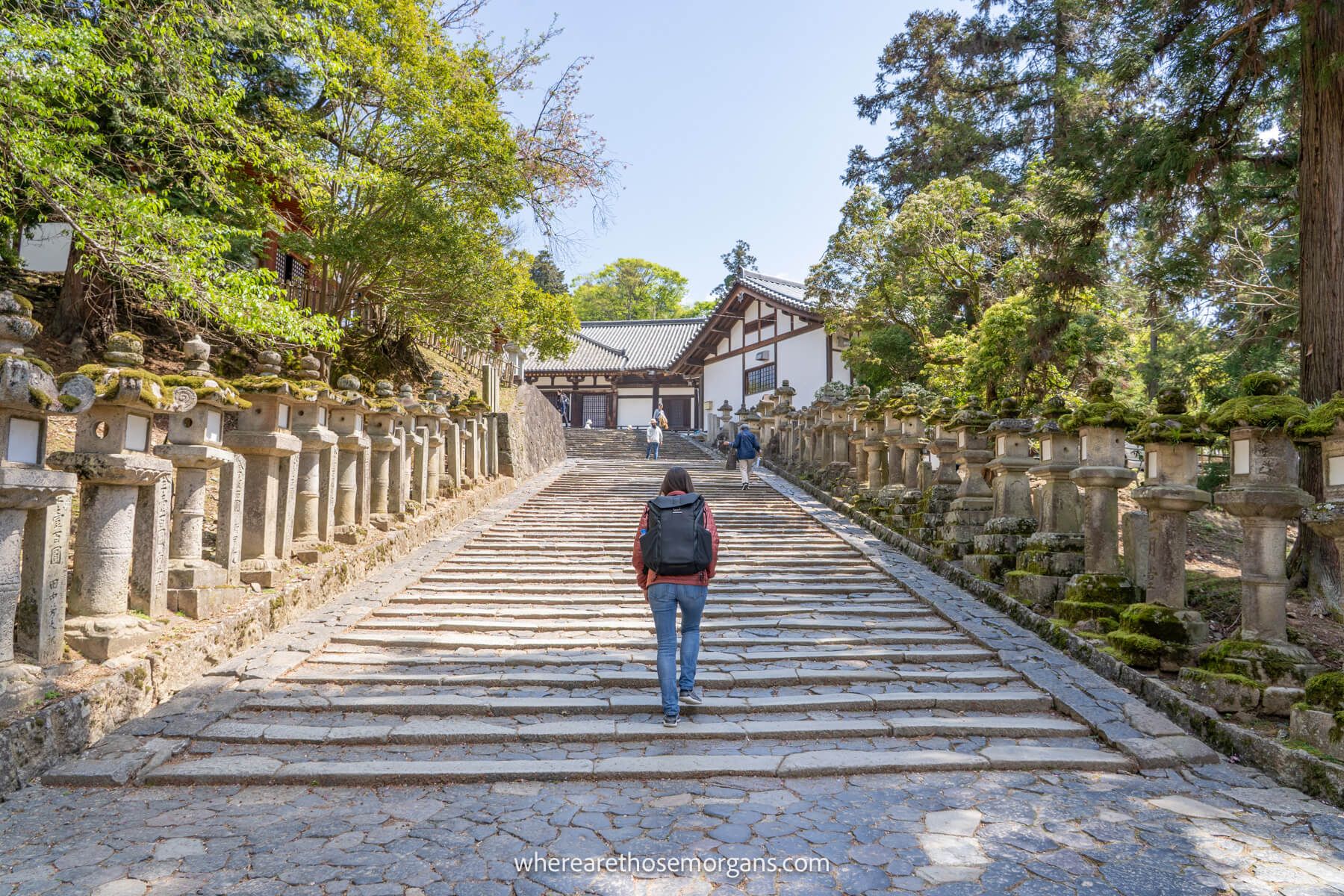 We chose the stone walkway to the top
We chose the stone walkway to the top
To reach the temple we followed a path with cobbled stone steps flanked on both sides by stone lanterns (see Kristen in the photo above). But you can also look for a covered walkway to help shield you from the elements if you visit in the rain. Historical significance combined with natural beauty makes this temple a special spot.
Climb Mount Wakakusa
On the eastern edge of the deer park near Todai-ji and Nigatsu-do, another great vantage point is Mount Wakakusa (Wakakusayama). It rises 342 meters high and has awesome views of the city from an observation deck about half way up, and you can connect to the trail right from Nigatsu-do.
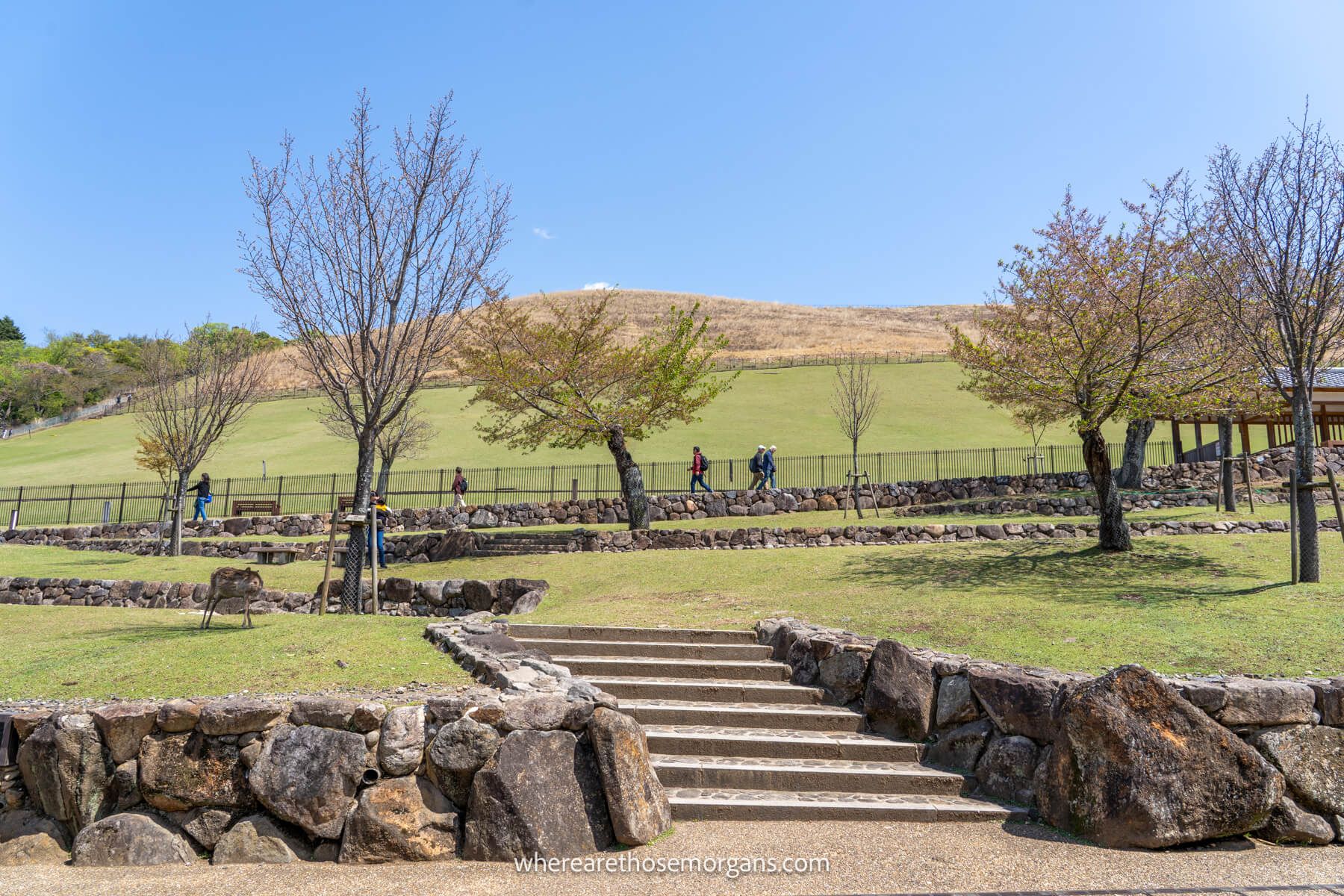 Side profile of Mount Wakakusa
Side profile of Mount Wakakusa
The entire mountain is completely covered in grass with no trees and it reminds us of the peaceful English countryside. Similar to the Omizutori ceremony, Mount Wakakusa is set on fire during the Wakakusa Yamayaki festival on the fourth Saturday in January.
According to AllTrails, the hike is 3.5 miles and should take about 2 hours to complete. The trail is out and back so you can turn around at the halfway point or you can continue all the way to the top. When we hiked, we saw tons of deer roaming around this area.
See Kofuku-ji Temple
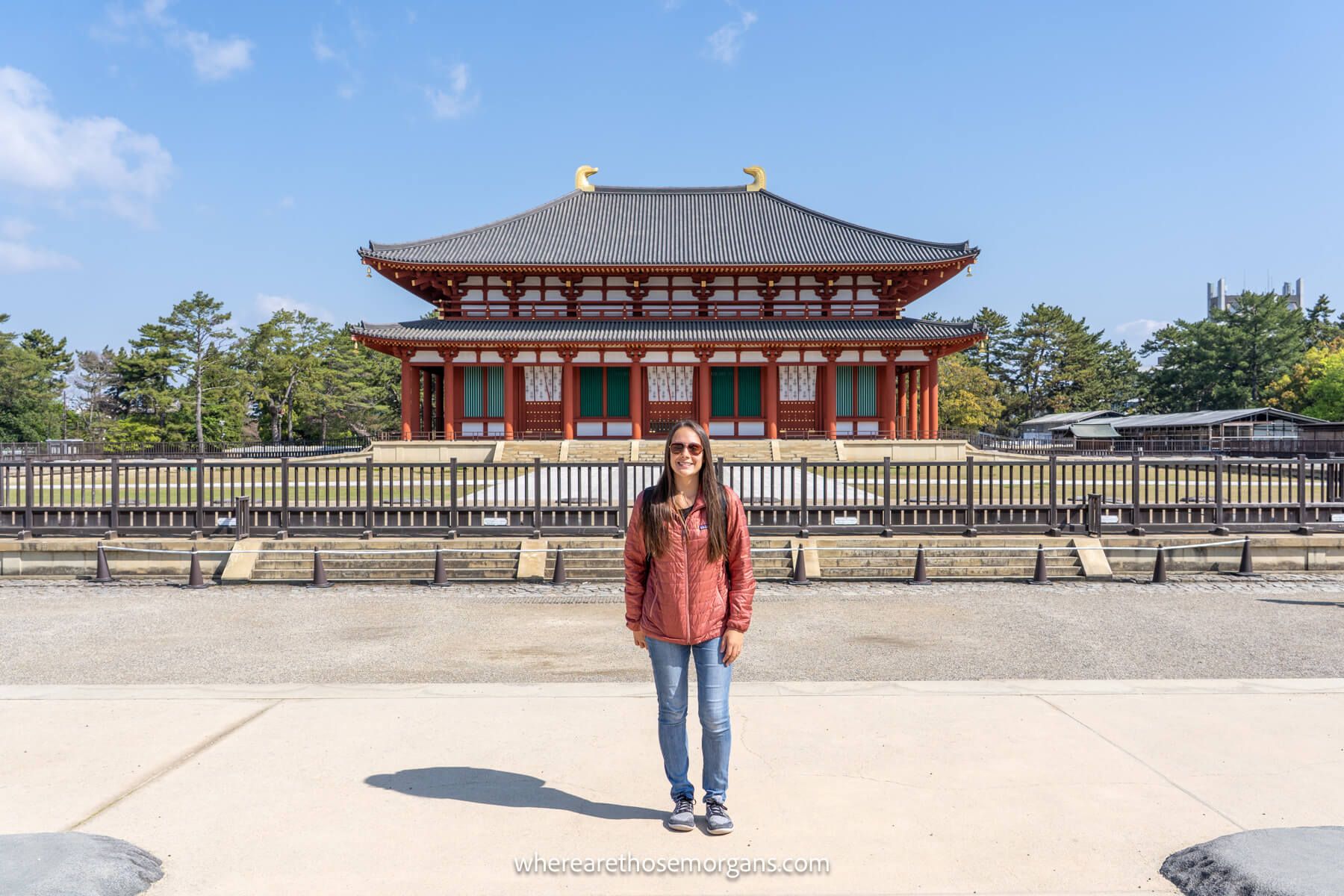 Kristen standing in front of the famous temple
Kristen standing in front of the famous temple
Kofukuji Temple is a complex of 7 buildings and grounds located just inside the western edges of Nara Park. It’s most famous for it’s five-story pagoda (the second tallest in Japan) which is beautifully reflected in nearby Sarusawa-ike Pond. This is one of the places we always visit when we’re in town because it’s one of Japan’s oldest and most famous Buddhist temples.
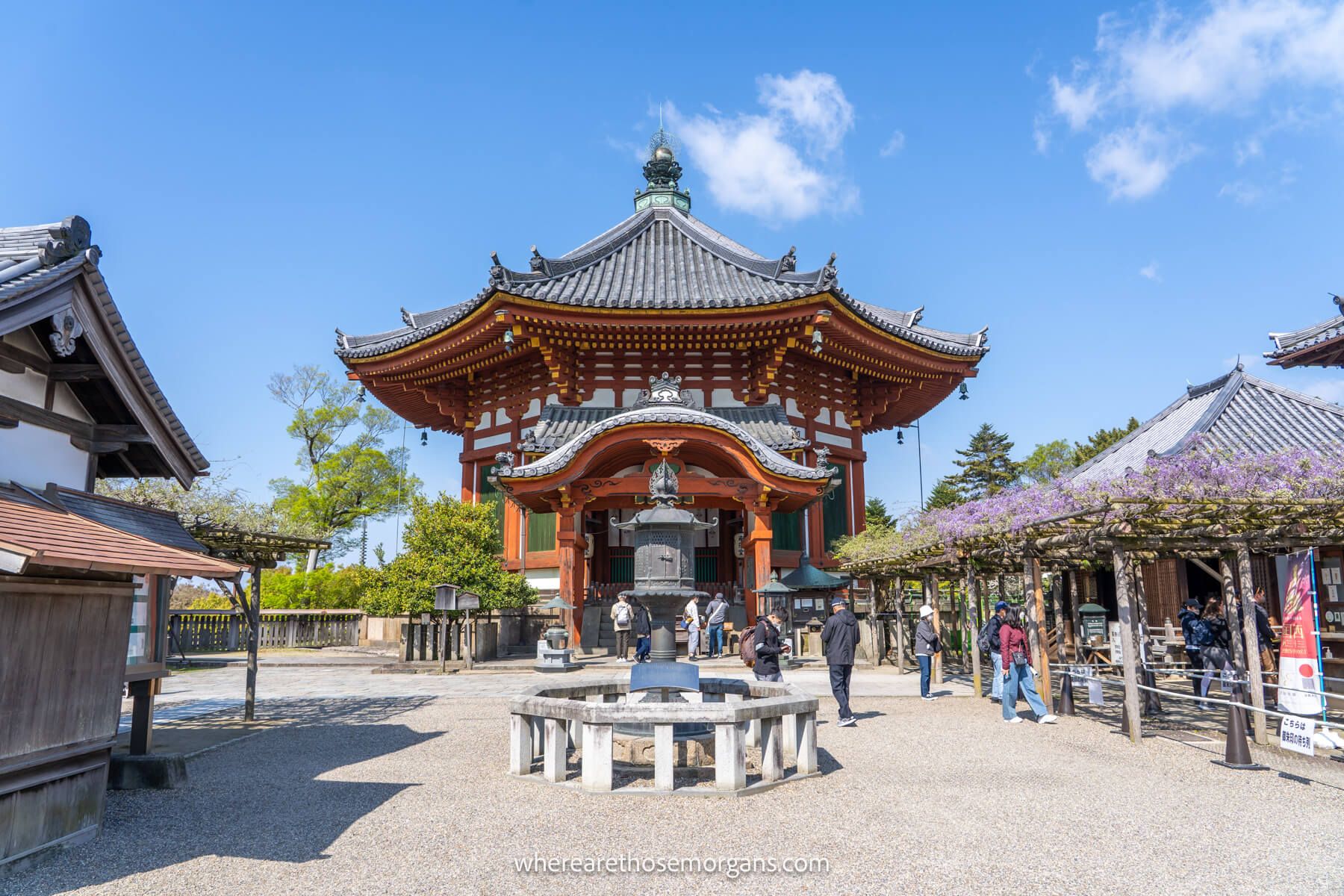 Visitors walking around the Southern Round Hall
Visitors walking around the Southern Round Hall
On our most recent visit, we also went inside the National Treasure Hall which we thought was well worth visiting because it houses sculptures from the 700’s. Many of the artifacts have Japanese explanations, but we could usually find short English description nearby and we also used Google lens to translate. It wasn’t always perfect, but we could understand the main points.
The grounds are free to enter, but you’ll have to pay to access the National Treasure Hall (¥700), Central Golden Hall (¥500) or Eastern Golden Hall (¥300). You can also buy a combined ticket for the National Treasure Hall and the Eastern Golden Hall for (¥900).
Photography is not allowed inside any of the buildings, but you can take photos of the exteriors. Here’s the official website if you want to know more.
Photograph Kasugataisha Shrine
If you want to take some beautiful pictures during your trip, we highly recommend visiting the Kasugataisha Shrine. It’s one of Nara’s most celebrated Shinto shrines, and it’s famous for both stone and bronze lanterns that have been donated by worshippers.
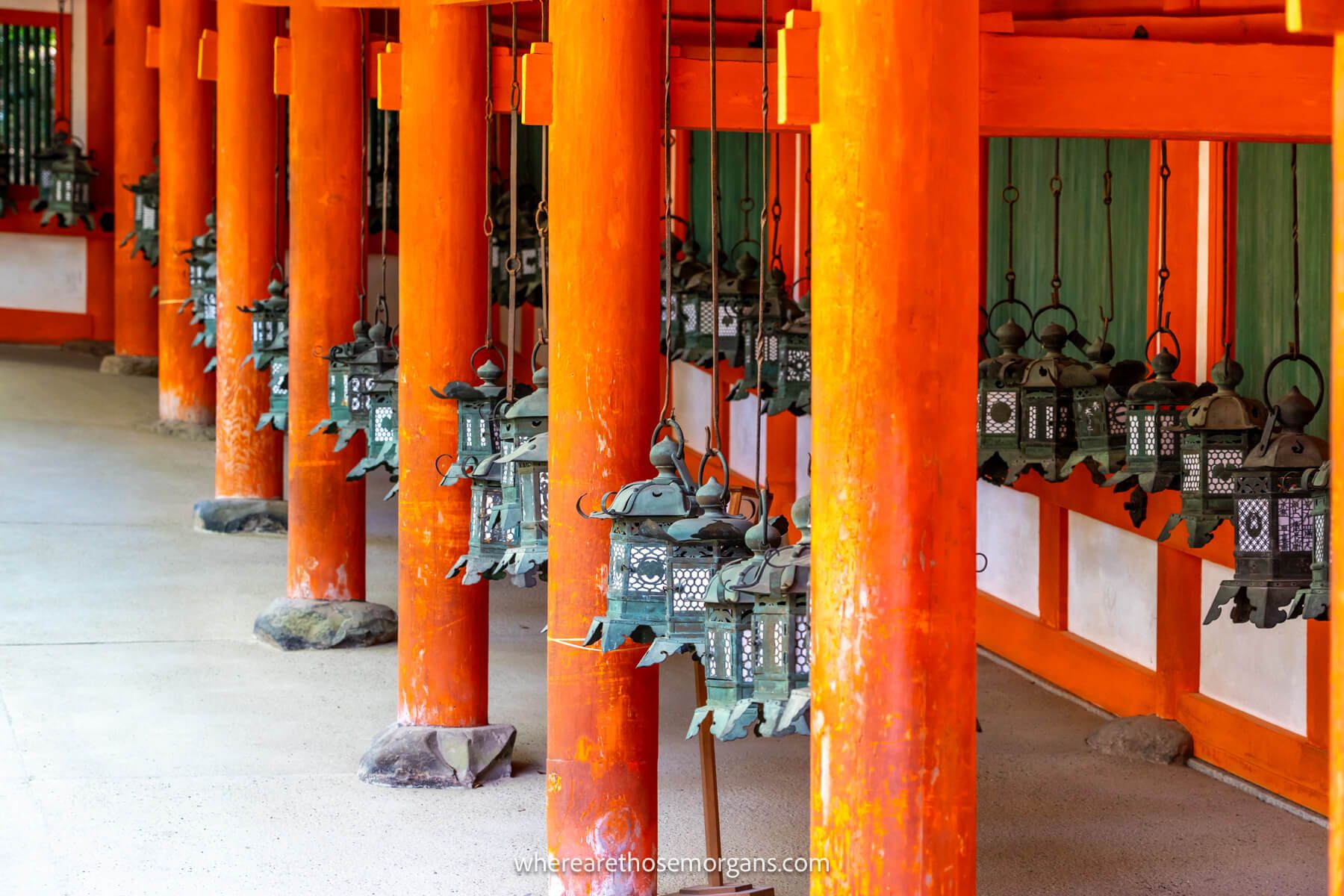 We love the beautiful bronze lanterns hanging outside
We love the beautiful bronze lanterns hanging outside 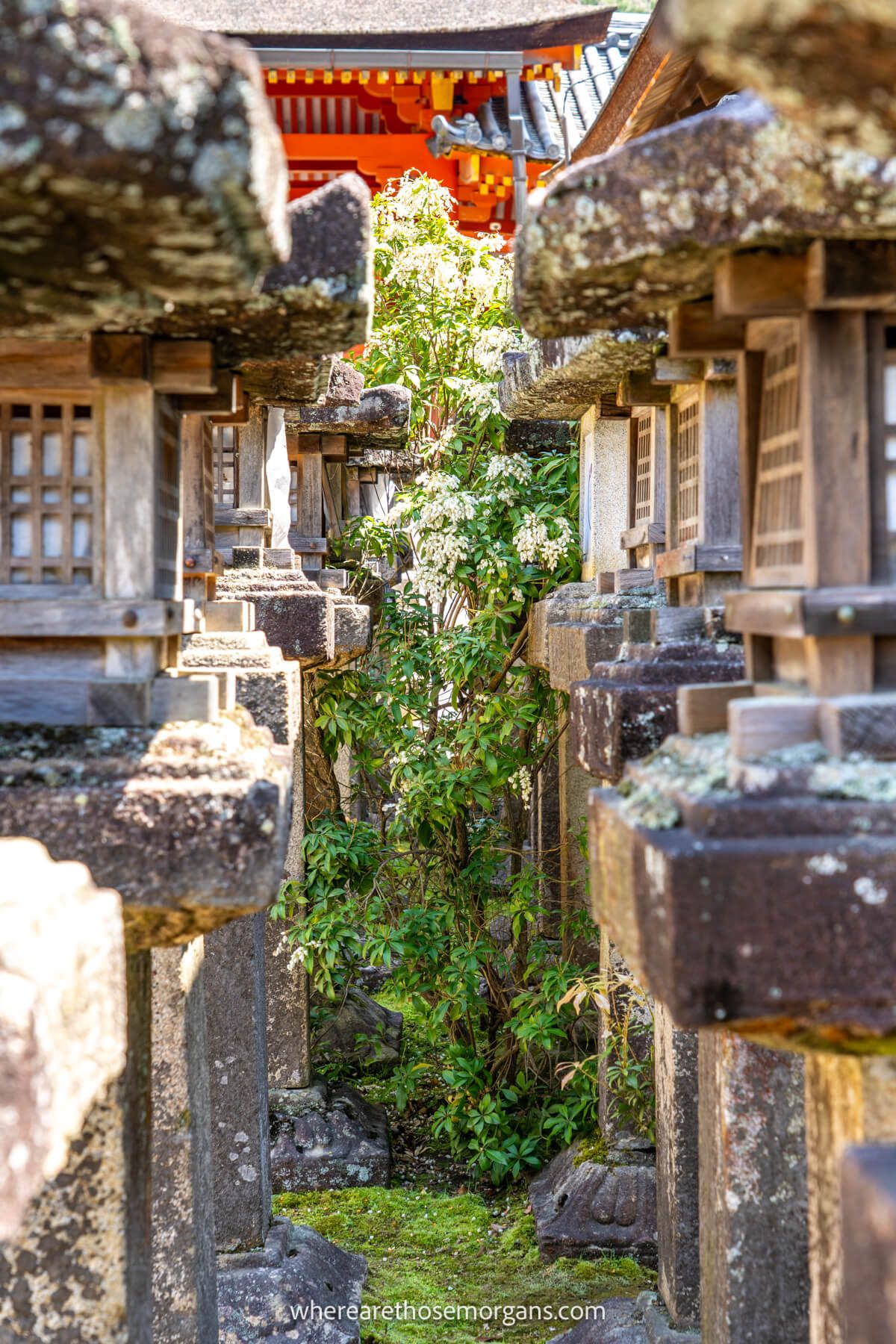 You’ll find gorgeous stone lanterns throughout the entire grounds
You’ll find gorgeous stone lanterns throughout the entire grounds
It was originally built in 768 and holds religious significance. Every February 3rd and August 14-15th, thousands of lanterns are lit in unison to signal the beginnings of spring and fall respectively.
One of the things we loved about the shrine was the picturesque walkway as we approached. It was lined with trees exploding with color from weeping cherry blossoms and wisteria flowers. Seeing the blooms during our last trip made it really special. The main sanctuary costs ¥700 for entry and the museum is another ¥500. For a map and additional information, visit the official website here.
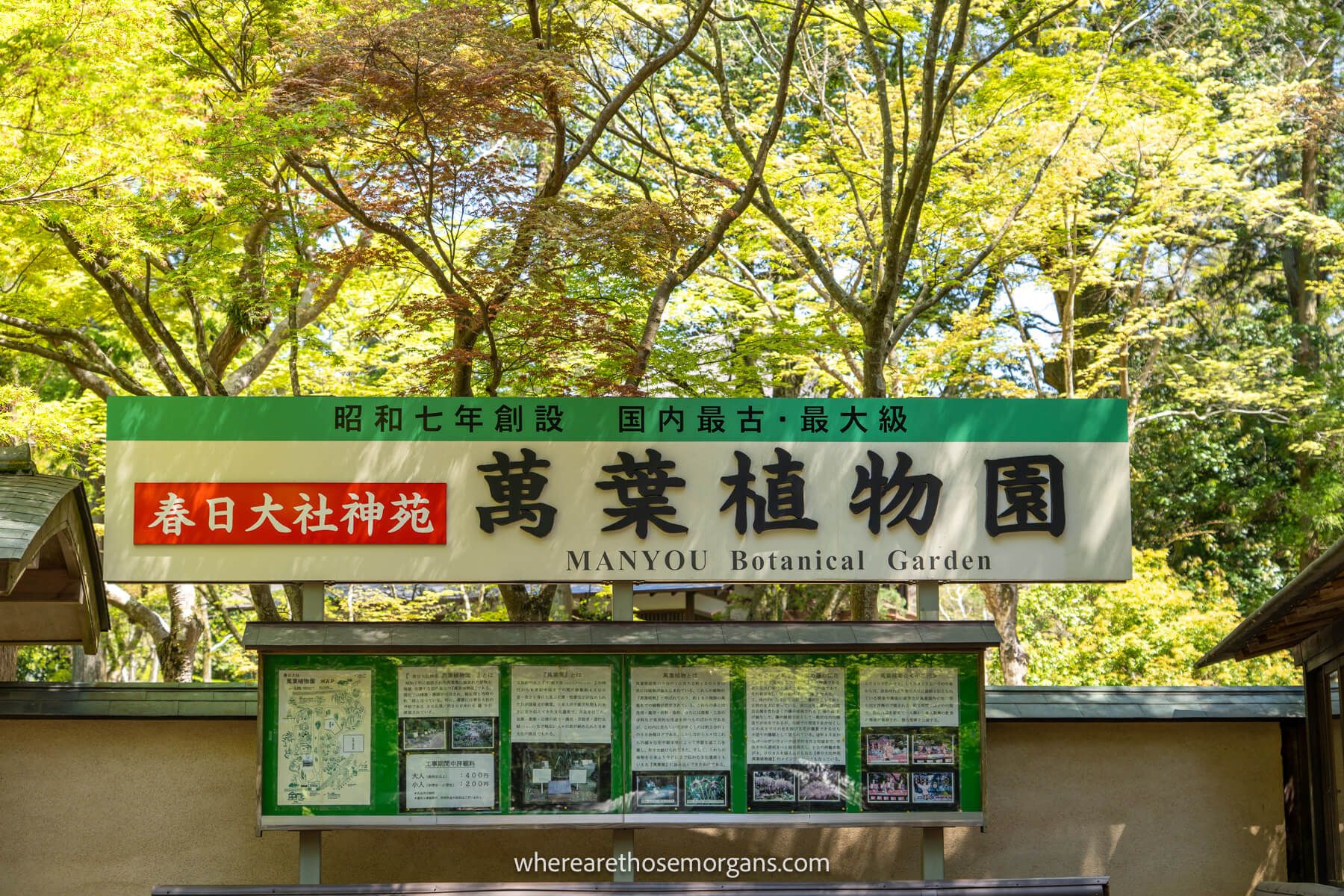 Look for signs leading to the botanical gardens
Look for signs leading to the botanical gardens
Another popular spot nearby is the Manyo Botanical Gardens. It’s filled with 300 kind of plants including camellia, irises and over 200 wisteria which are the main attraction. One of the things we liked about this garden was the small transcriptions next to each plant representative of Man-yo-shu, Japan’s oldest collection of poems. To see the garden at its best, visit late April to early May.
Travel Tip: We like to use a shortcut behind Kasugataisha Shrine. Look for picturesque paths leading to Todaiji Temple, Kofukuji Temple and Mount Wakakusa through the sacred Kasugayama Primeval Forest.
Feed The Sika Deer
Deer are considered messengers of God in Buddhism and they’re allowed to roam freely around all areas of Nara. The park is home to a reported 1,200 deer that approach humans and cross the roads like it’s their turf. The deer were one of the main reasons we first visited Nara and you honestly have to see the laissez-faire attitude of these deer to believe it.
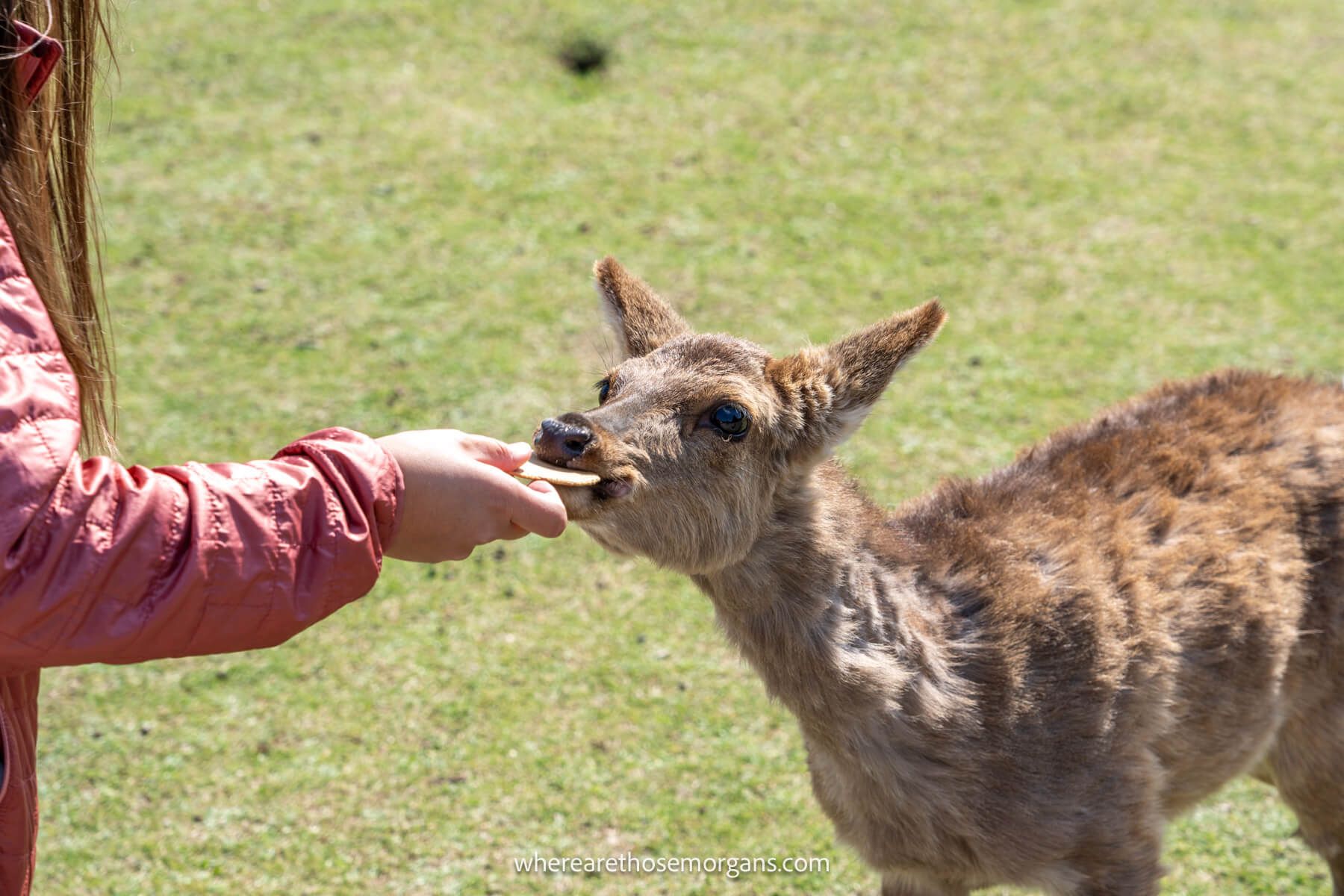 Kristen feeding a cracker to one of the sika deer
Kristen feeding a cracker to one of the sika deer
One question you may have is how do all these deer survive in a city park? The answer is you feed them. That’s right, you can buy a special cracker type snack called “shika senbei” from vendors around the park to feed the deer with. But the deer here are so used to humans feeding them now that they can get rather pushy…or bitey!
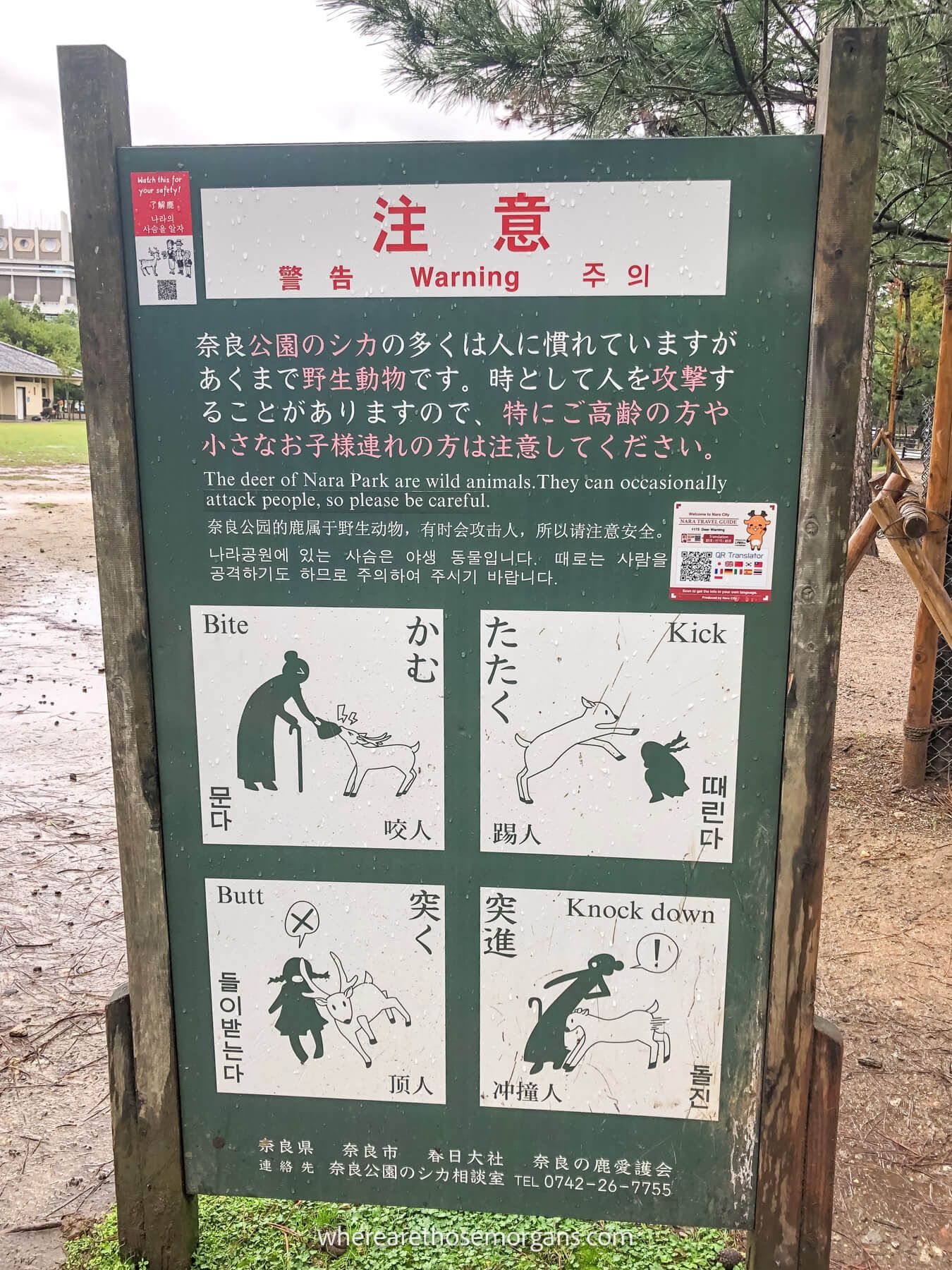 A typical warning sign in Nara
A typical warning sign in Nara
The wooden sign in the photo above is one you’ll see all over town and it reminds us of a Pokemon’s moves… bite, kick, butt and knock down. Just don’t be the person who needs taking to the Pokemon Center to revive! We’ve written an entire guide about how not to get bitten by a deer and we highly recommend you read it before visiting Nara.
Travel Tip: Once you run out of food, show the deer your palms with fingers spread out. This lets the deer know you have no more food.
Find The Two Gardens
The two gardens you can visit in Nara are called Isuien Garden and Yoshikien Garden. We didn’t have enough time for them on our first trip which we regretted, so we made sure to add them in during our second trip. If you’ve never experienced the beauty of a Japanese garden, this is an easy place to do it.
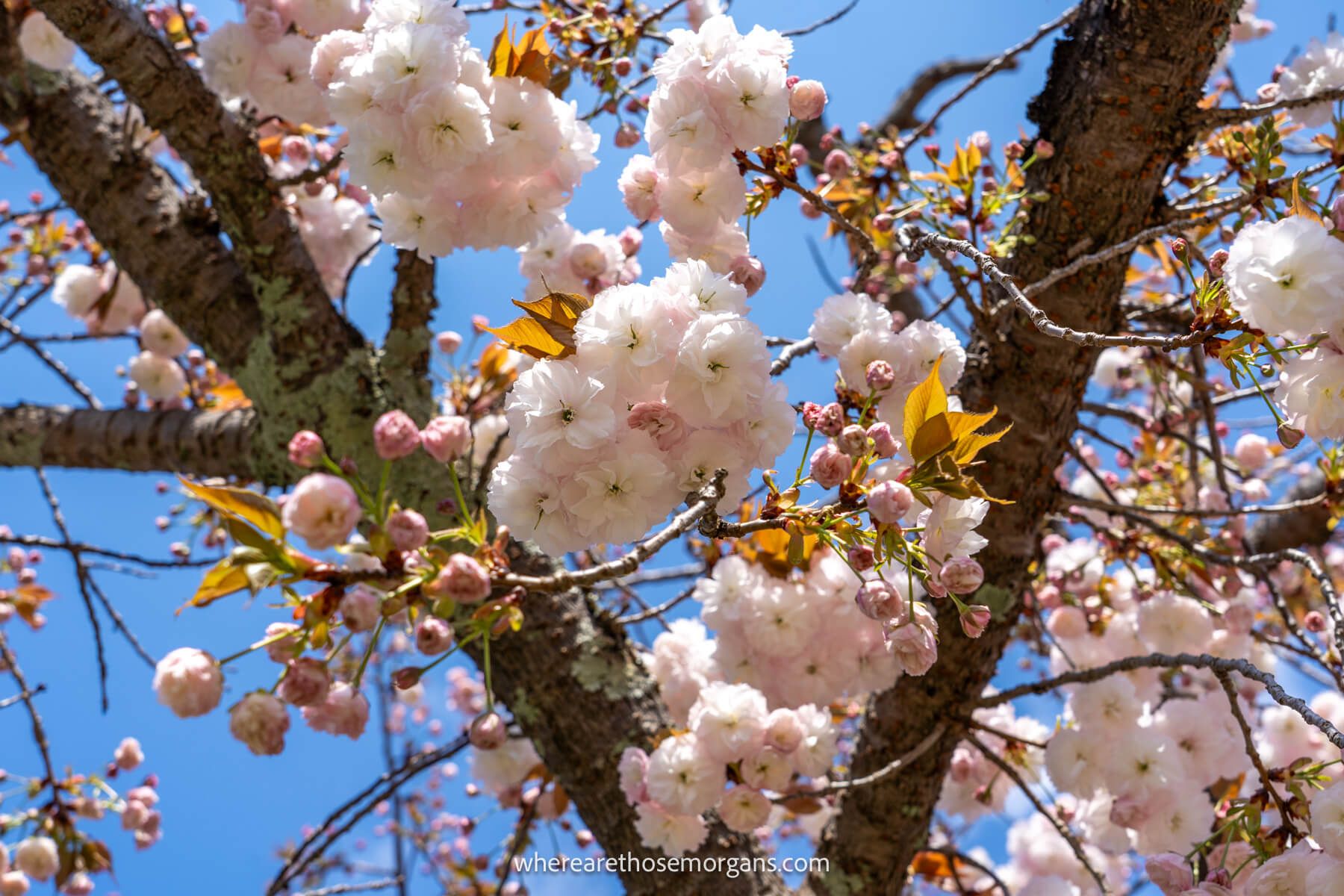 Cherry blossoms in bloom during the spring season
Cherry blossoms in bloom during the spring season
Isuien Garden is located near Todai-ji Temple’s Nandaimon Gate. It’s a stunning place divided into a front and back garden, with tea houses and brilliant water features. We could have easily spent an entire day exploring the grounds and we took so many photos of the garden reflected in the ponds. Admission is ¥1,200 and includes entry into the Neiraku Art Museum. It’s closed on Tuesdays so plan accordingly.
Yoshikien Garden is another gorgeous spot next to Isuien Garden, and it’s name is derived from the nearby Yoshikigawa River. We like Yoshikien because admission is free with a foreign passport and it’s a very relaxing place to walk through.
Our favorite time to visit is fall when red and orange leaves contrast against beautiful wooden tea house. It’s a hidden gem that’s often missed by visitors, so there should be fewer crowds compared to other parts of Nara.
Learn At Nara National Museum
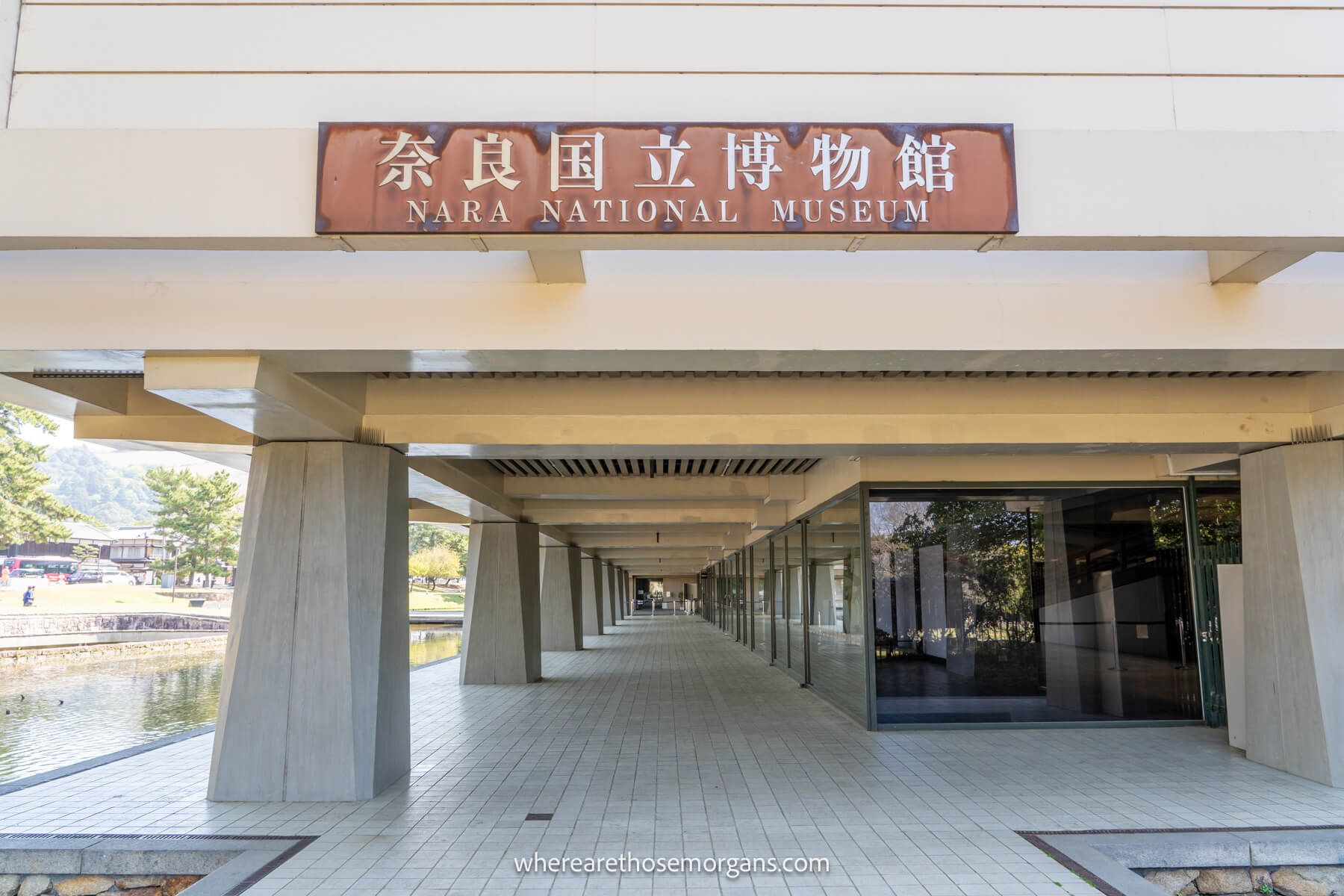 Main entrance to the Nara National Museum
Main entrance to the Nara National Museum
While you can visit national museums in Kyoto and Tokyo, we think the Nara National Museum is unique because it showcases a permanent collection of precious Buddhas and ancient Chinese bronze from the Shang (Yin) to Han dynasties. It also has special exhibits to explore.
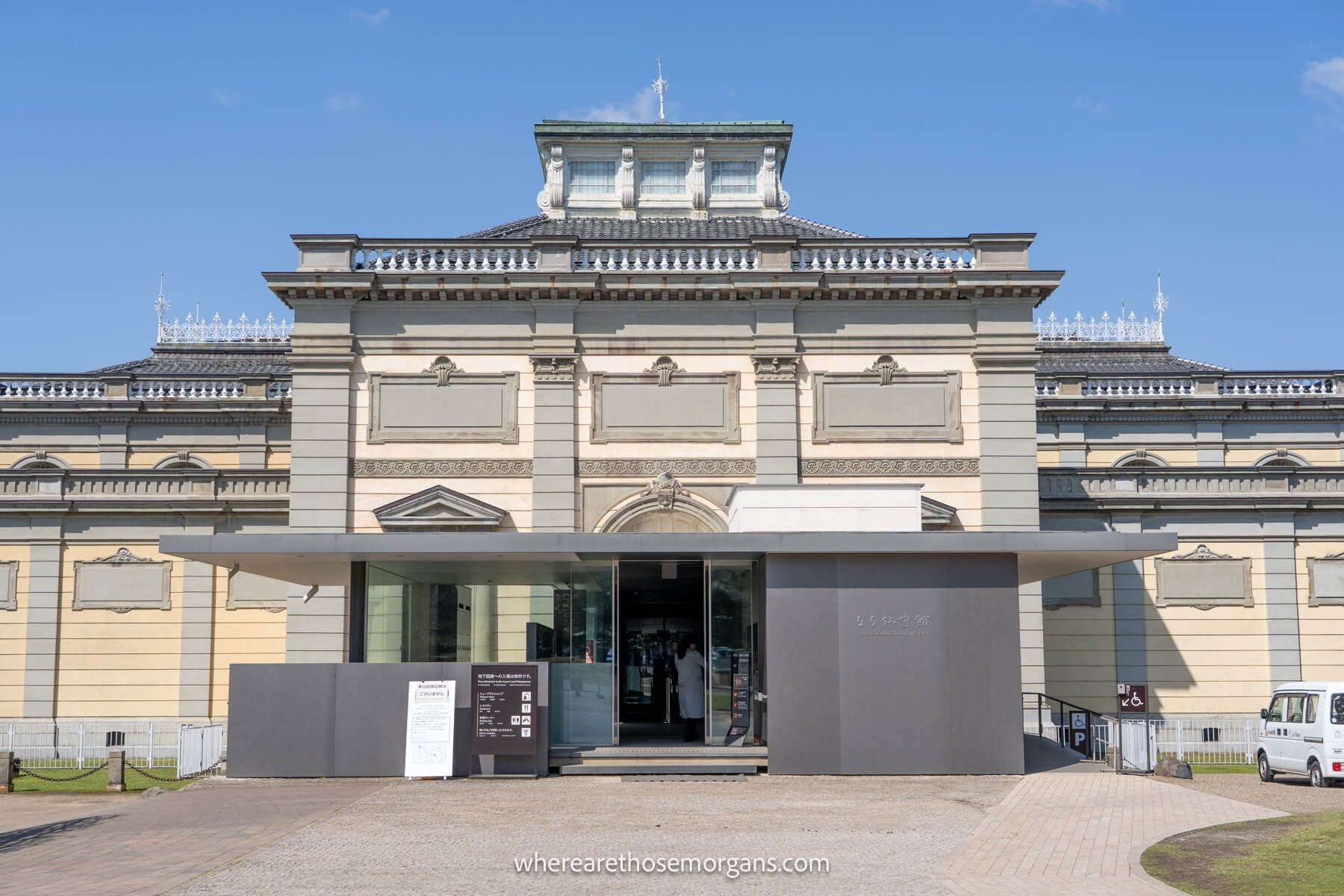 One of the main buildings you can go in
One of the main buildings you can go in
There are two buildings connected by an underground passage and we appreciated that English translation was provided for most of the artifacts. Admission is ¥700 and it’s open from 9:30am to 5:00pm. Here’s the official website if you want to know more.
Travel Tip: The Nara National Museum is a popular spot for spotting sika deer. We saw tons of them gathered around the buildings during both of our trips.
Stop By Sarusawa-ike And Ukimido Pavilion
One of our favorite photography locations in Nara is Sarusawa-ike, an artificial pond lined with willow trees that was originally created in 749 as part of Kofuku-ji Temple.
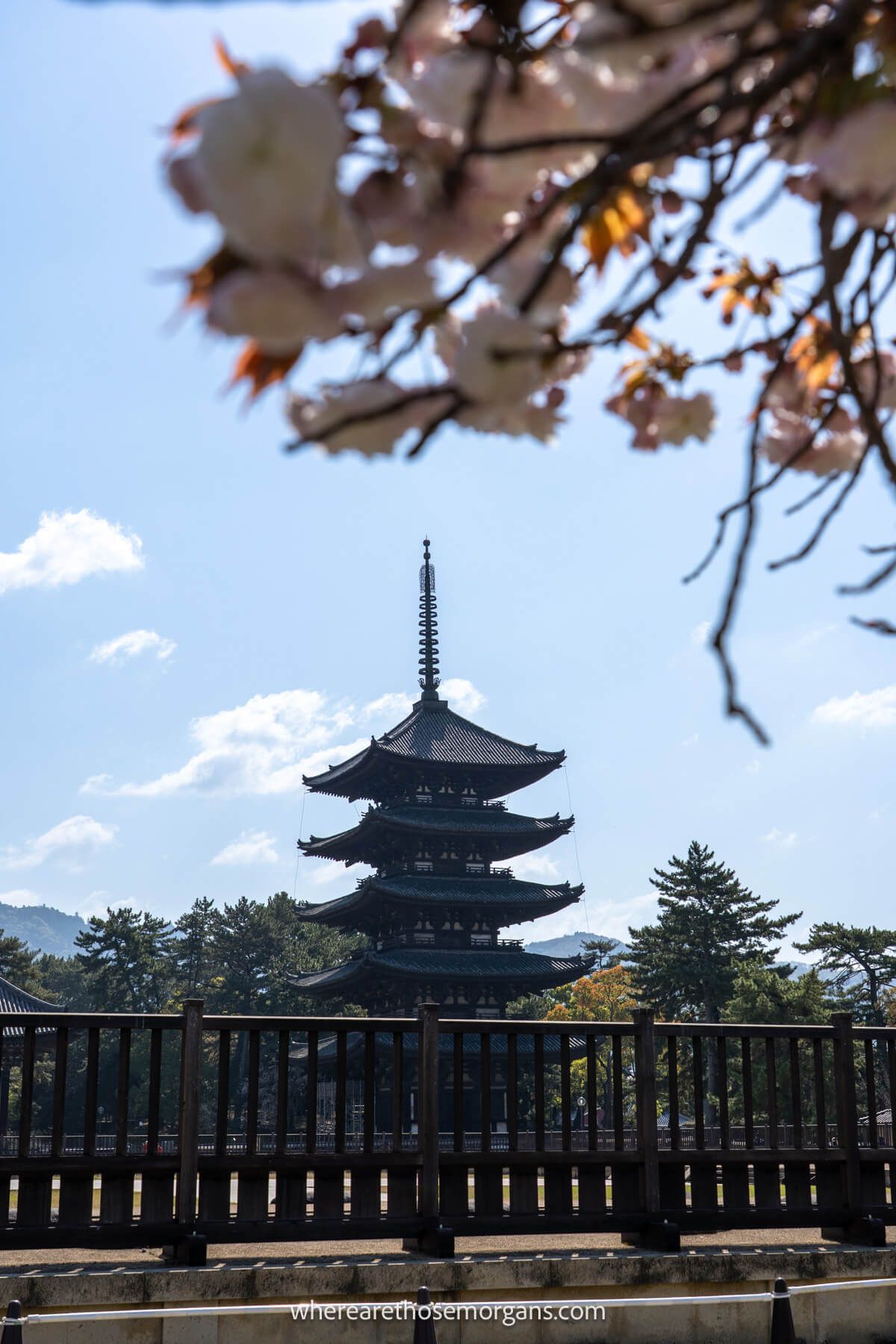 We can never get enough of this beautiful pagoda
We can never get enough of this beautiful pagoda
There’s a stunning view with the five-story pagoda reflecting in the water, plus we also saw herons and turtles sunning themselves on the rocks as we walked the perimeter of the pond during the day. It’s located just past the Sanjo Street shopping district near tons of hotels and restaurants.
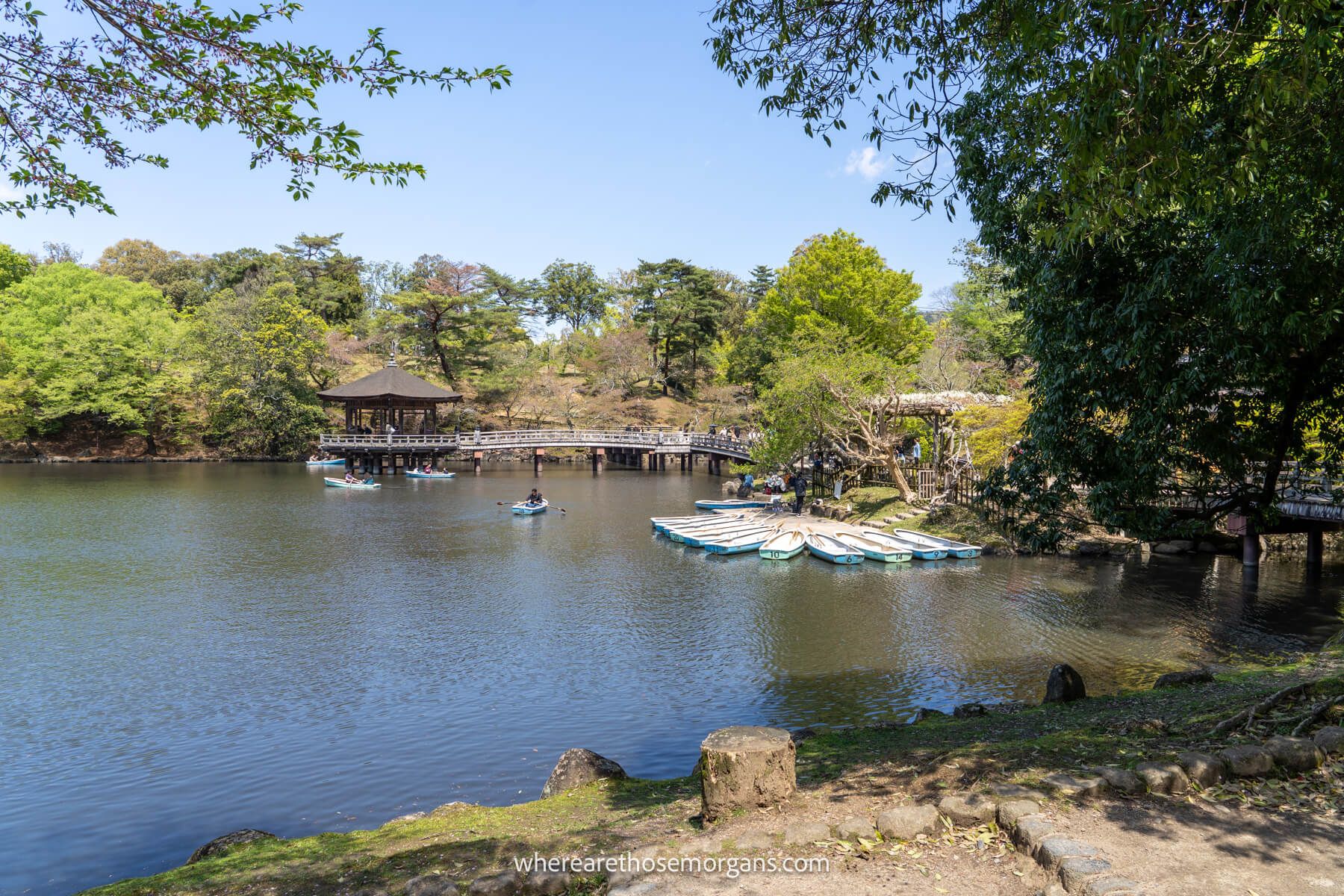 We love how picturesque this pavilion is against the pond
We love how picturesque this pavilion is against the pond
Another great photo spot is Ukimido Pavilion, which is a 15 minute walk from Sarusawa-ike on the outskirts of the park. If you visit on a calm day, you can see the pavilion reflected in the waters of Sagi Pond. It features a traditional thatched roof made from Japanese cypress bark and the best time to visit is at night when the pavilion is lit up.
 Kristen walking across the bridge
Kristen walking across the bridge
We recommend walking across the wooden bridge to the middle of the pavilion to enjoy the scenery, but you can also rent a rowing boat from late March to late November.
Drink At Harushika Sake Brewery
Sake is Japan’s national drink so it’s definitely something you should try during your trip, and Nara just so happens to be the birthplace of modern refined sake. What a pleasant coincidence! It’s made from rice, water and koji – a fungus cultivated from steamed rice, and the good news is you can try some right in town at the Harushika Sake Brewery.
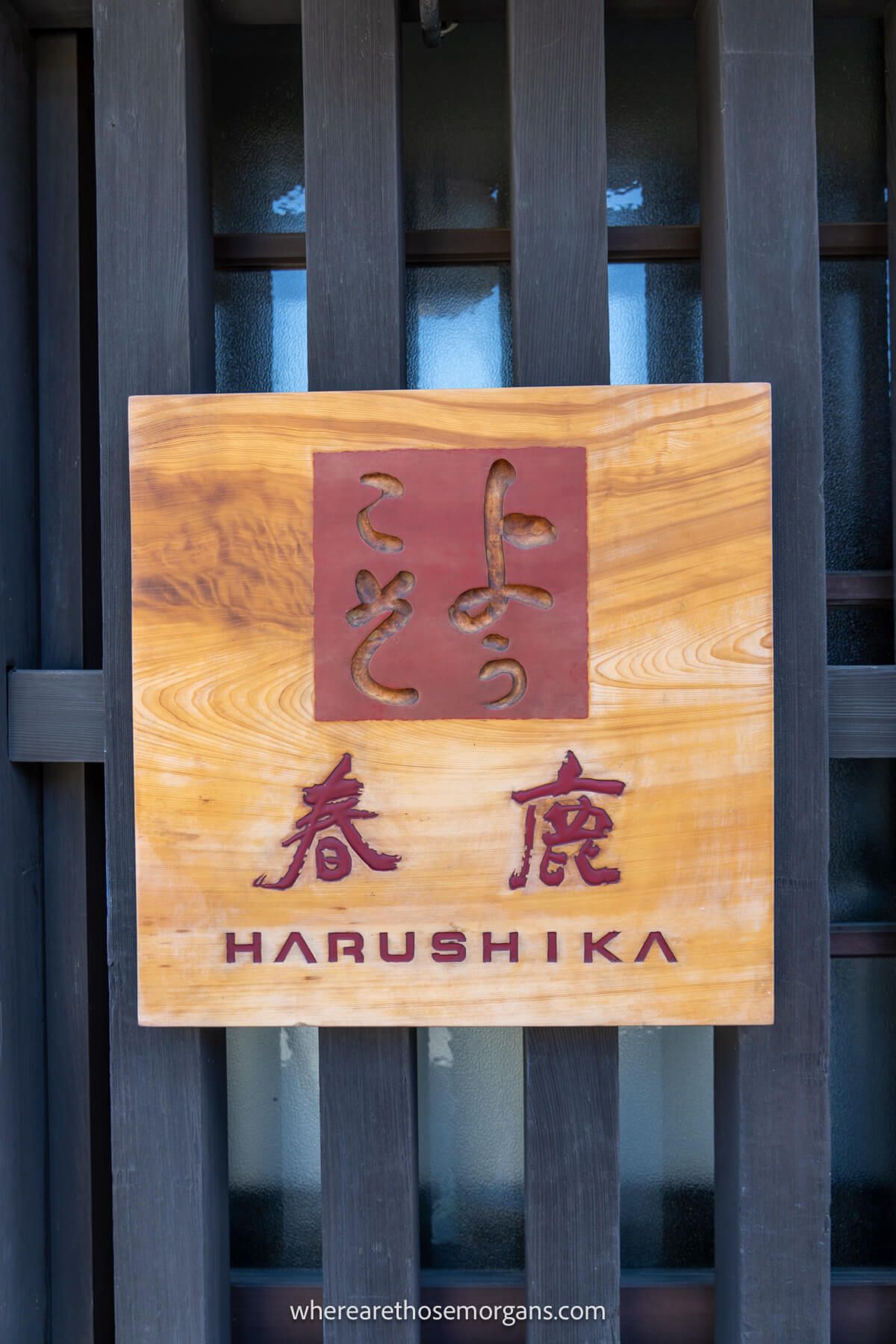 Look for this sign outside the brewery
Look for this sign outside the brewery
A highlight during our last trip was being able to try several different kinds of sake as we learned how it was made. If you give it a try, expect to pay about ¥700 for a tasting of 5 different flavors.
Tours In Nara
Now that we’ve covered everything you can do in Nara, we think it might be worth booking a tour if you’re short on time. In hindsight, we wish we used a tour for our first trip because we didn’t know where to go and we missed some of the best spots in town. Many of these tours are round trip and begin in Kyoto or Tokyo so you don’t have to worry about transportation.
Here are some top rated options:
 People walking around the crowded streets of Nara
People walking around the crowded streets of Nara
The city of Nara often gets overshadowed by temples and deer in the park. However, the city itself is actually a really fun place to walk around. It has a relaxed vibe and the locals are incredibly friendly.
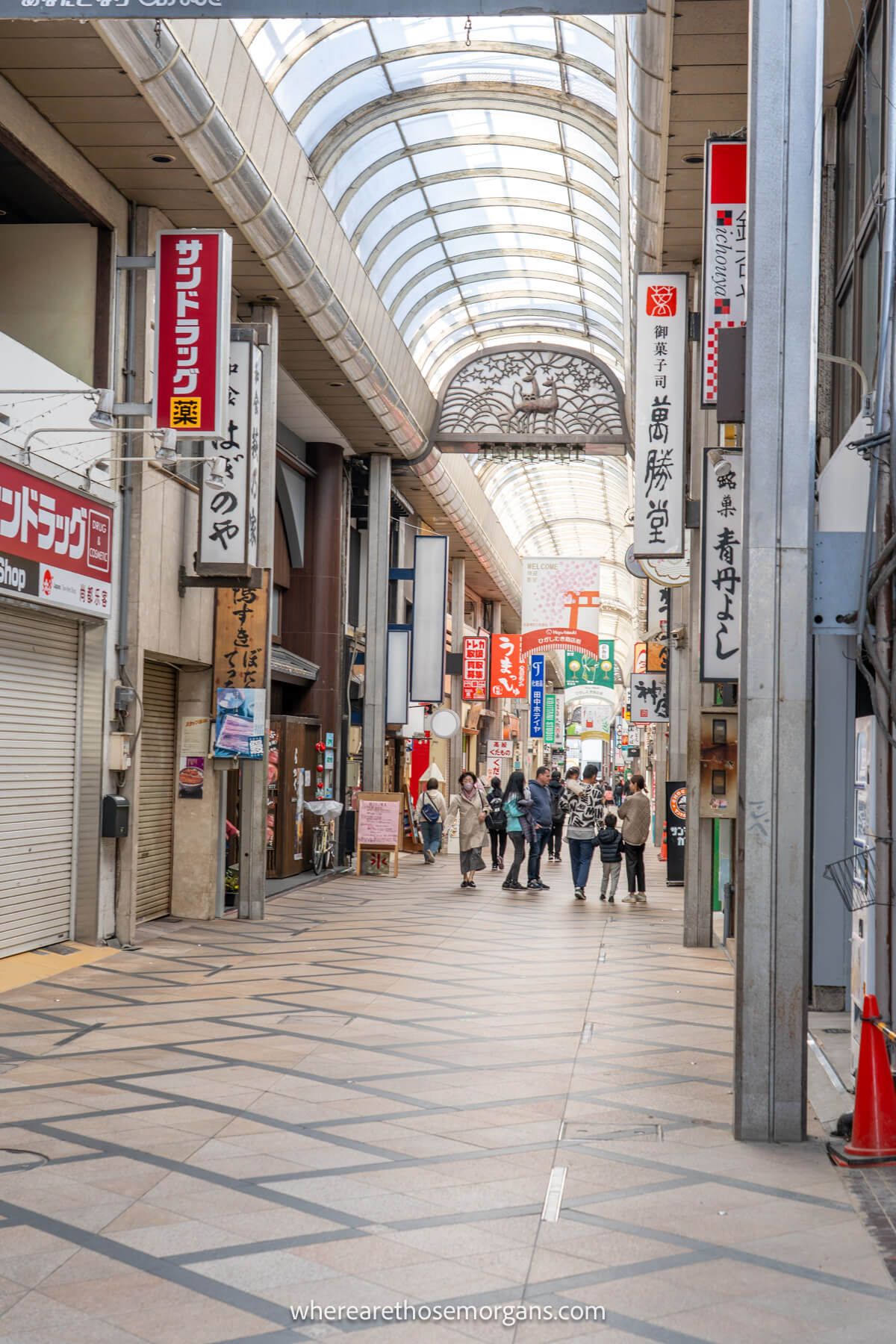 People strolling around the main shopping center
People strolling around the main shopping center
Nara has a small collection of arcades like most Japanese cities today, just not on the scale you’ll see in Tokyo or Osaka.
We always find arcades in Japan to be such an interesting contrast to the old world charm around every other corner, and if you want old world in Nara, head into Naramachi to see places like the Lattice House (Naramachi Koshi-no-Ie in Japanese). We found it so peaceful walking around the quieter streets south of town.
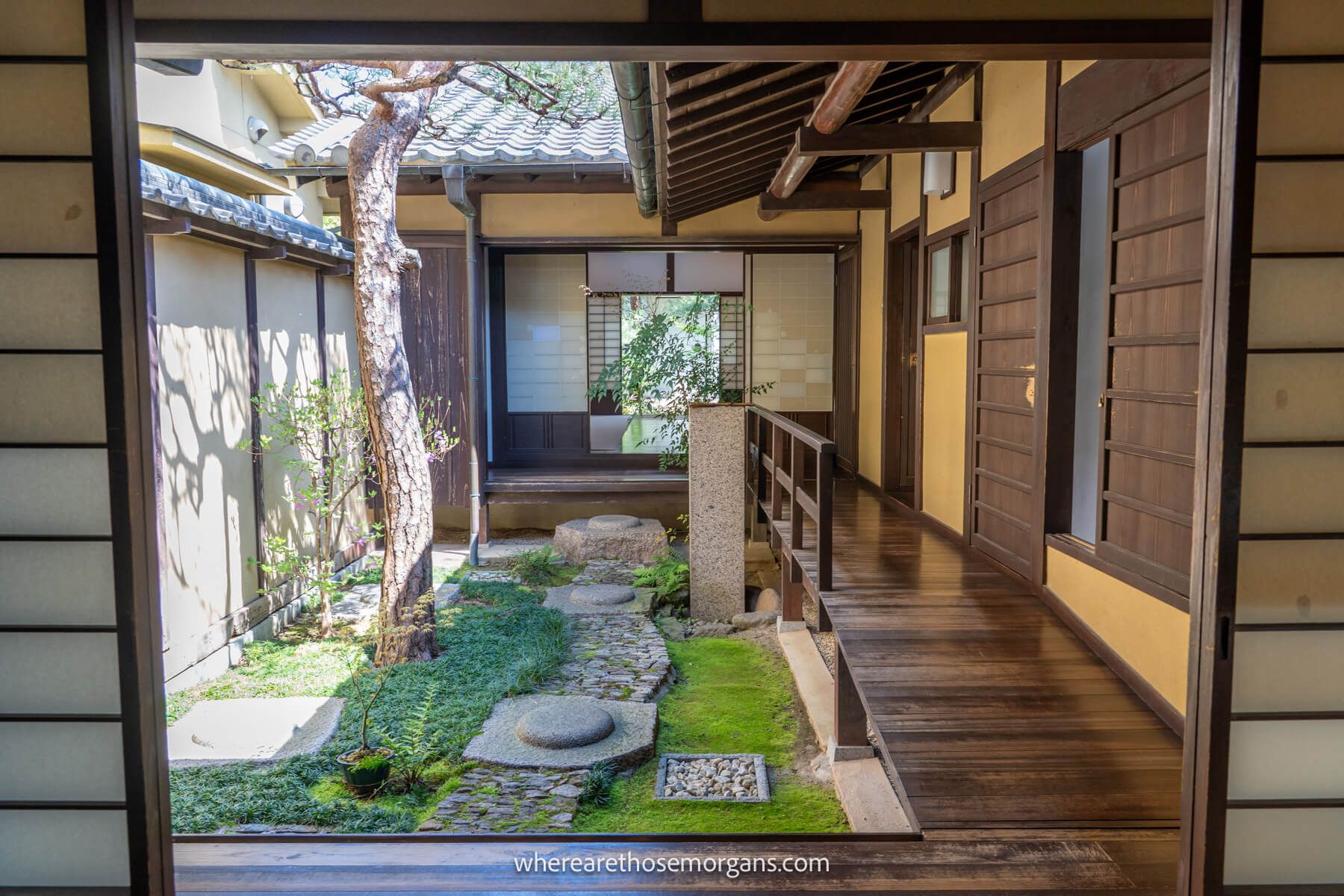 The lattice house is extremely picturesque
The lattice house is extremely picturesque 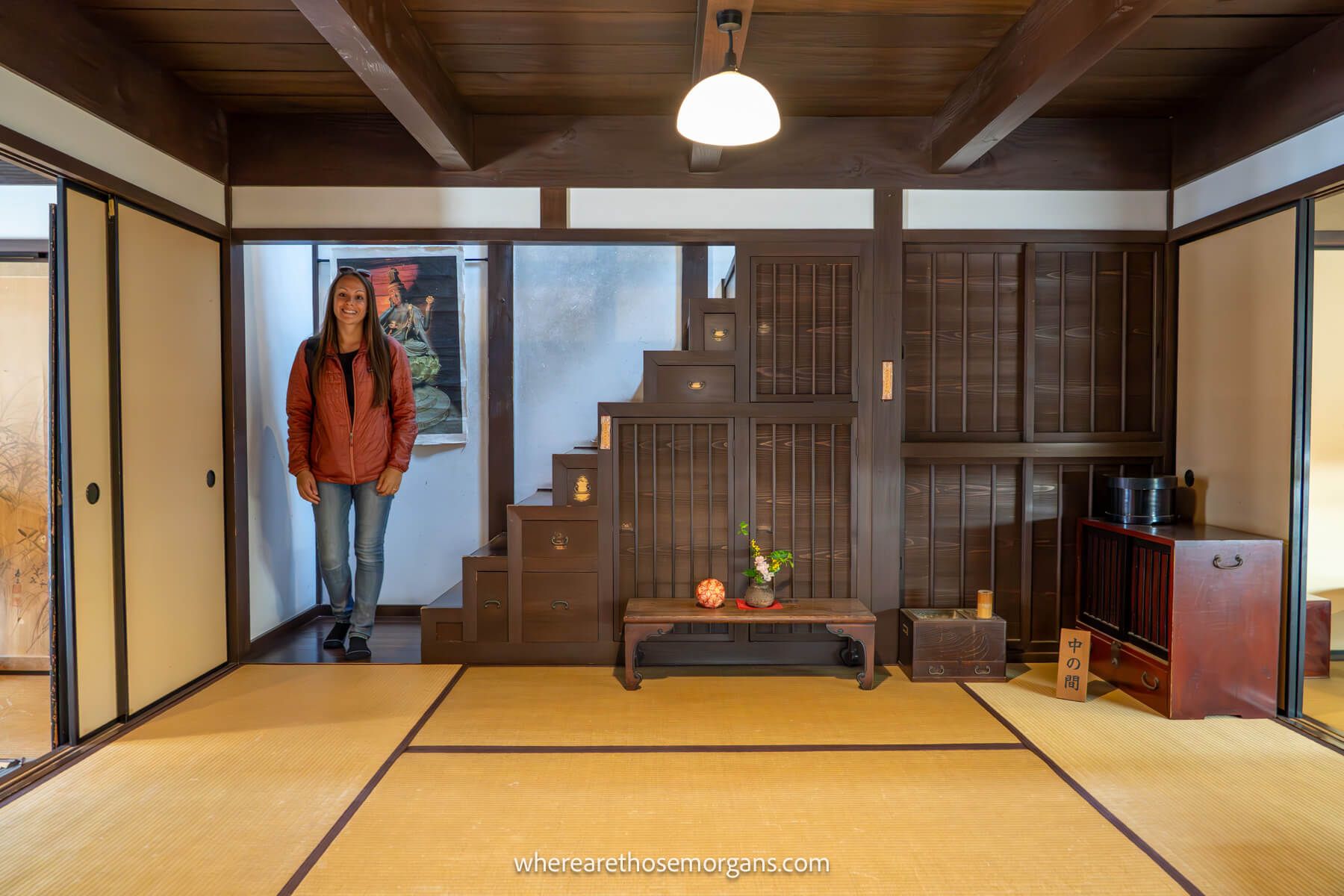 Even the staircase makes a great photo
Even the staircase makes a great photo
Back in town, one of the most popular spots we visited was Higashimuki Shopping Street. The covered arcade was filled with restaurants and souvenir shops, and we spent a lot of time there during our first trip when we got rained out.
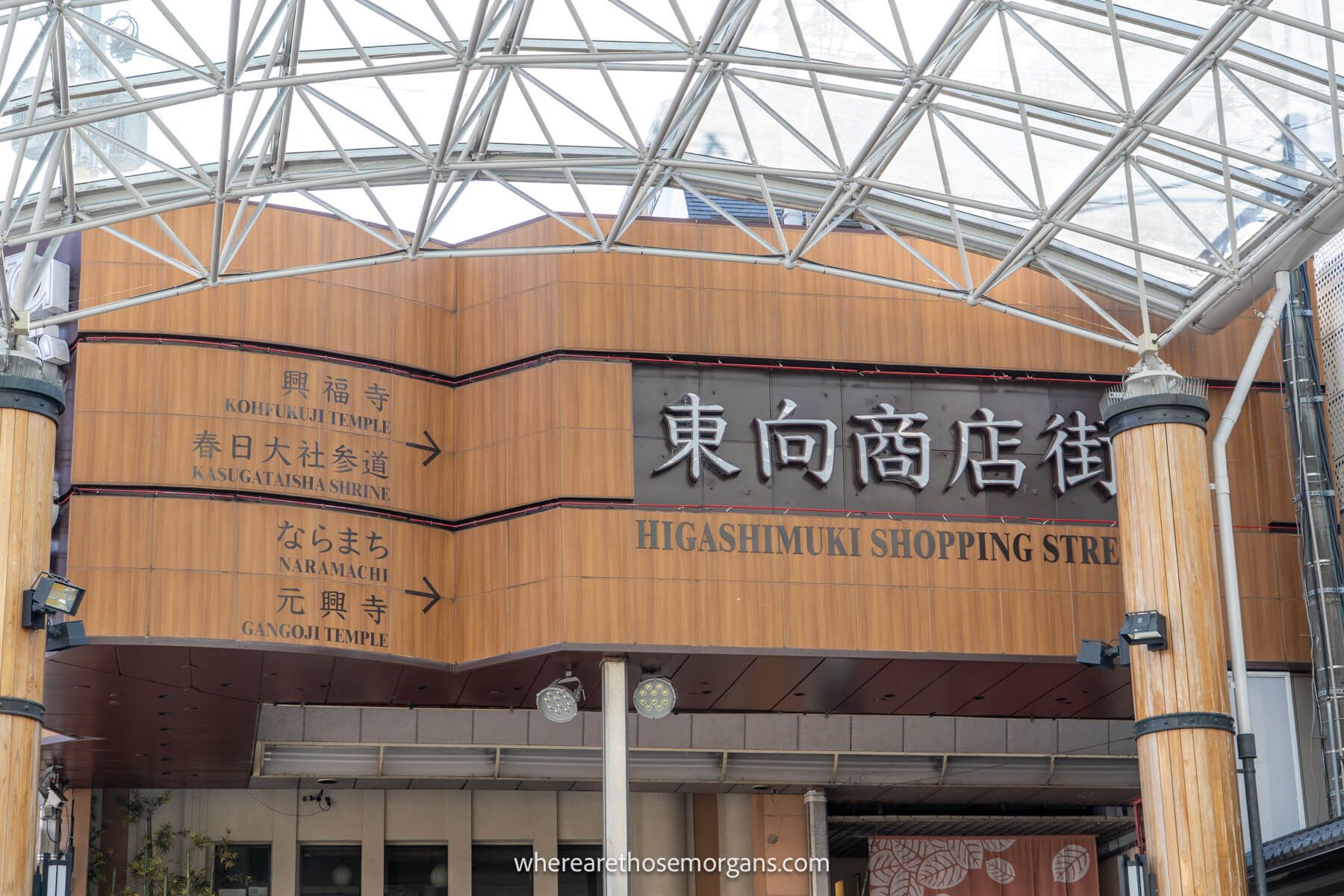 You’ll see this large sign as you enter the city from the train station
You’ll see this large sign as you enter the city from the train station
For such a small city there’s certainly no shortage of dining options and we were surprised by the amount of excellent restaurants on offer. Here are just a few top rated places to eat:
- Kura – Cozy little izakaya with great food
- Naramachi Vegan Nabi – Vegan and gluten free options
- Sakura Burger – Popular hamburger and hot dog joint
- Surugamachi’s Okonomiyakiya – Great little okonomiyaki spot near the train station
- Wa Yamamura – Michelin star option serving traditional Japanese dishes
There are also a few restaurants located with the deer park:
- Le Case – Small pie shop serving tasty sweet and savory quiche
- Mizuya Chaya – Traditional teahouse within nature serving noodles
- Nagomi – High end steak and teppanyaki restaurant
Nara Attractions Map
Click or touch the map below to activate, zoom in and out, and scroll around. If you’d like to see a bigger version, click the “view larger map” icon in the top right, and if you’d like to see anything specific, click the arrow and square icon in the top left.
Map key:
- Red – Attractions
- Blue – Restaurants
We hope our version of the best things to do in Nara helps with planning your trip!
Please let us know if you have any questions in the comments below.
Happy Travels,
Mark and Kristen
Find our guide helpful? Pin it for later!

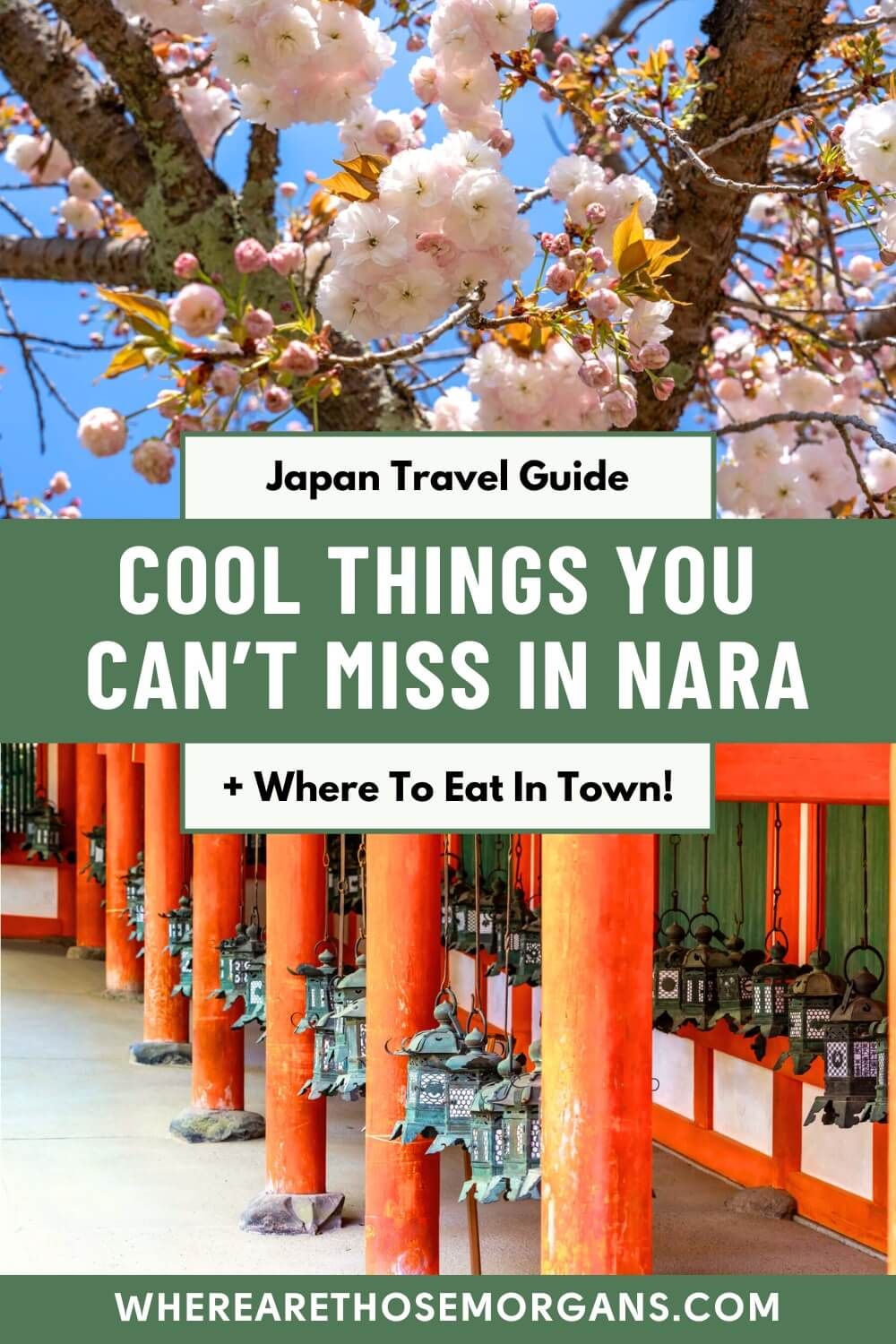
All Rights Reserved © Where Are Those Morgans, LLC. Republishing this article and/or any of its contents (text, photography, maps, graphics, etc.) in whole or in part is strictly prohibited.

Mark and Kristen spent 6 years traveling the world, visiting over 40 countries across 4 continents and more than 30 US states. They created Where Are Those Morgans in 2018 to help others plan the best possible vacations by writing authentic travel and hiking guides based on their real experiences.
Since the arrival of baby Maya in late 2024, Mark and Kristen’s extensive travels have slowed down but they still take plenty of trips. Where Are Those Morgans now helps millions of travelers each year to visit new places and hike new trails through information-packed blog posts and expert travel guidebooks. Read more about Mark and Kristen.
